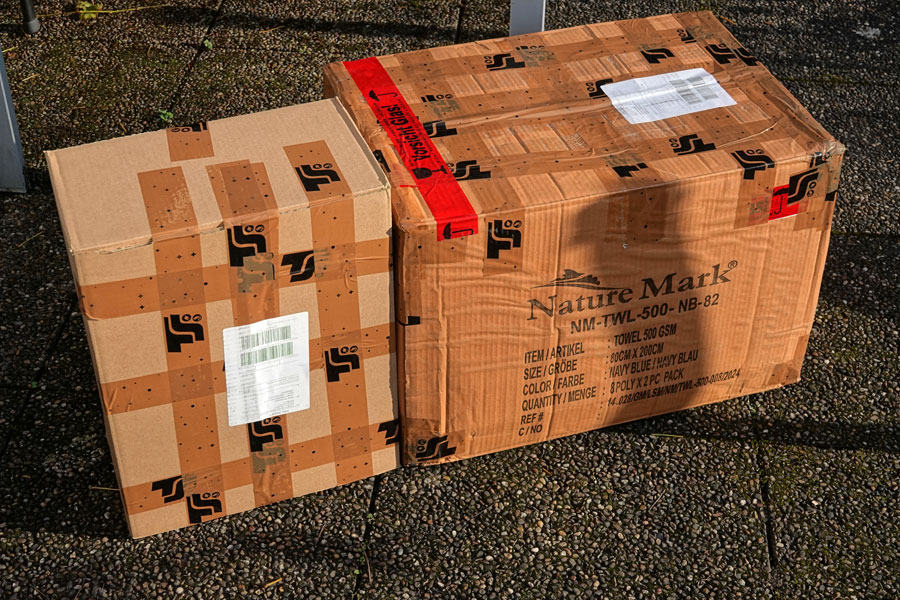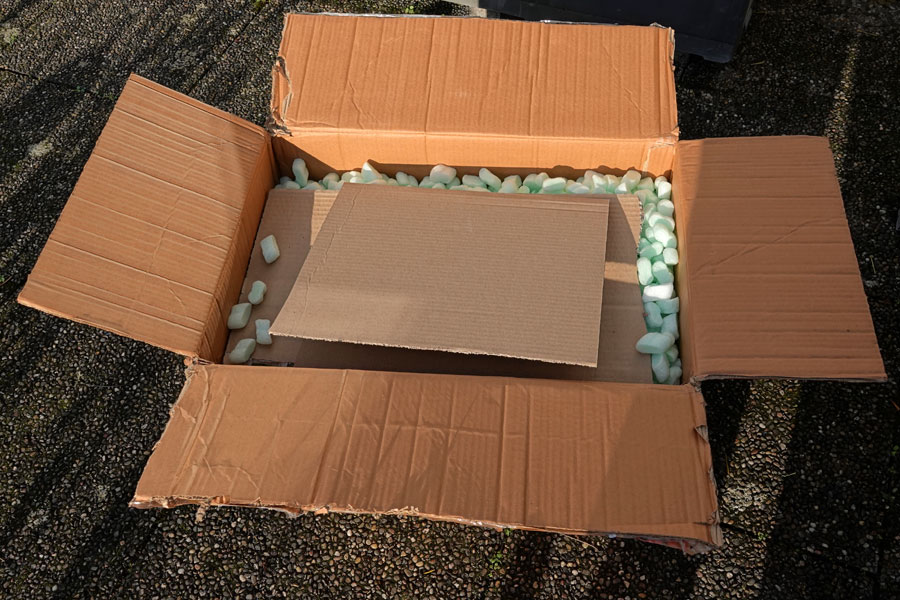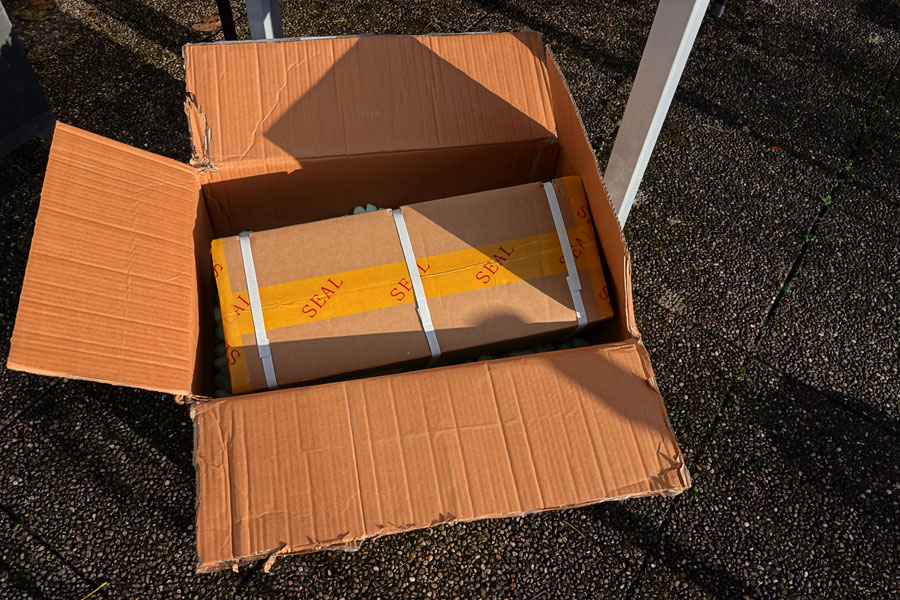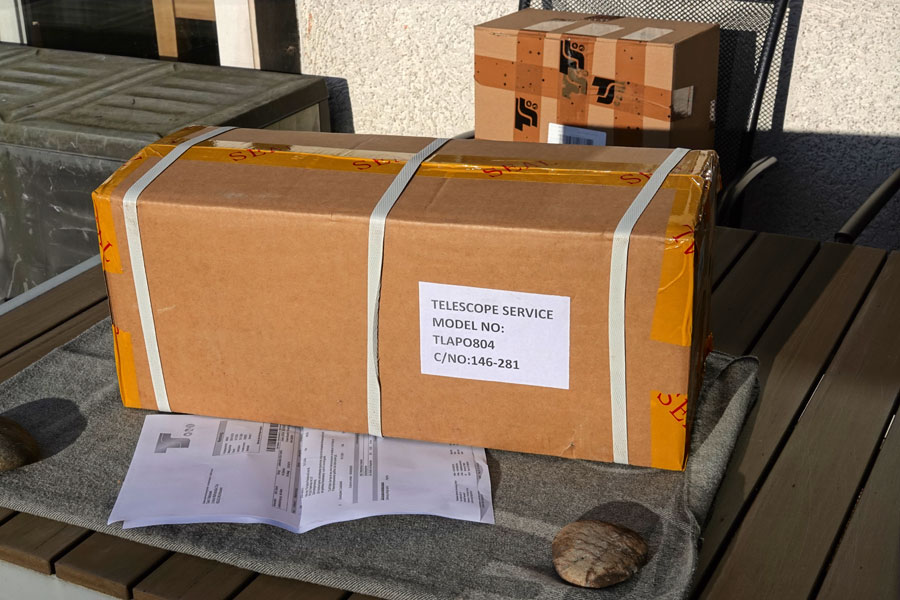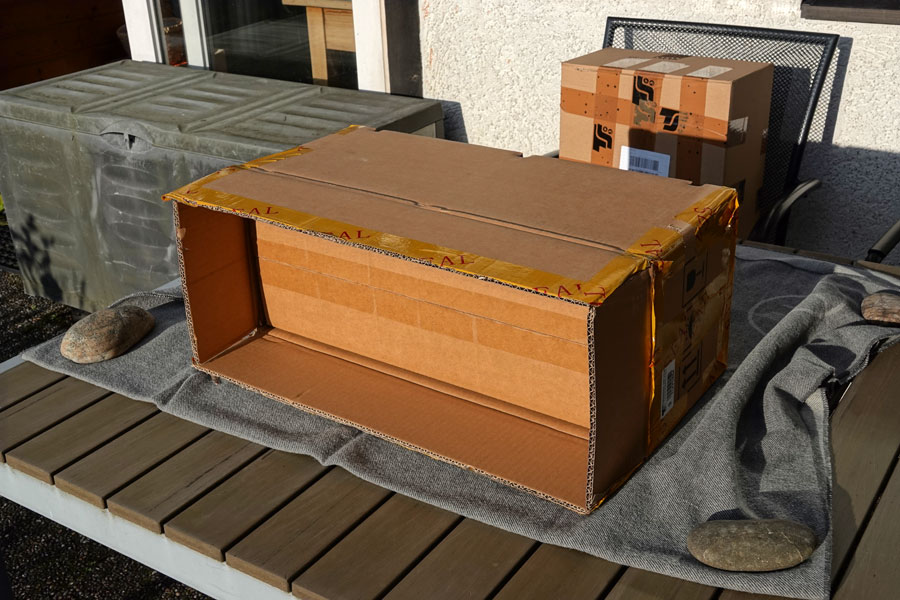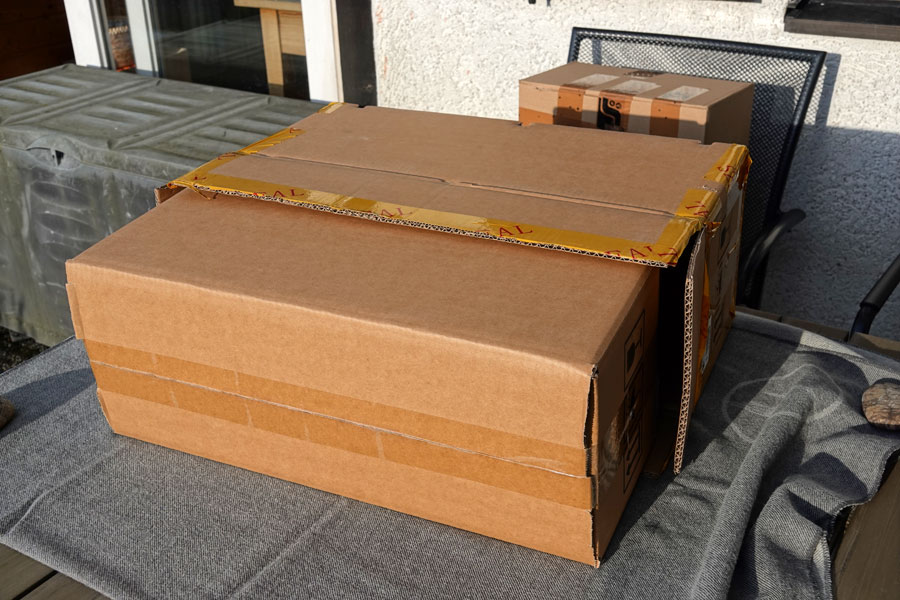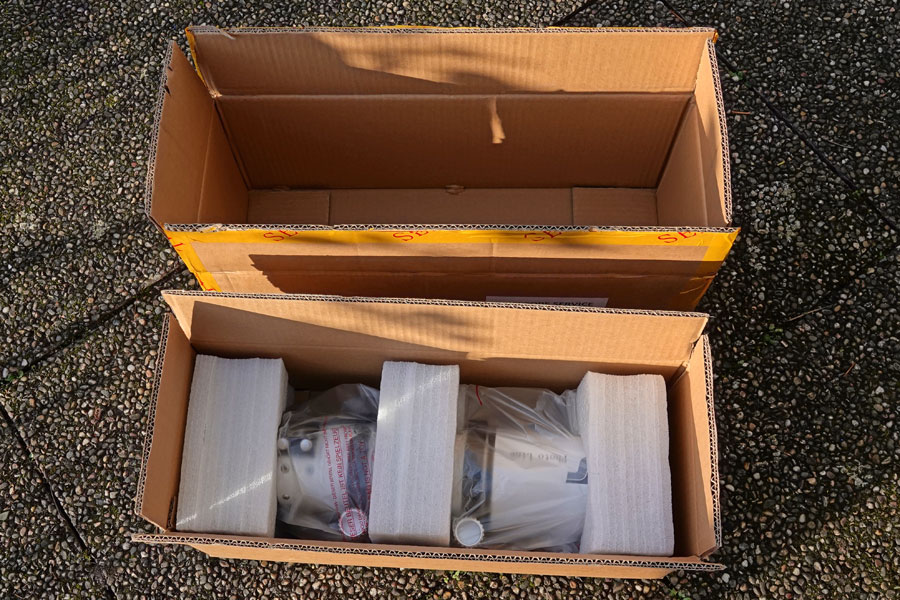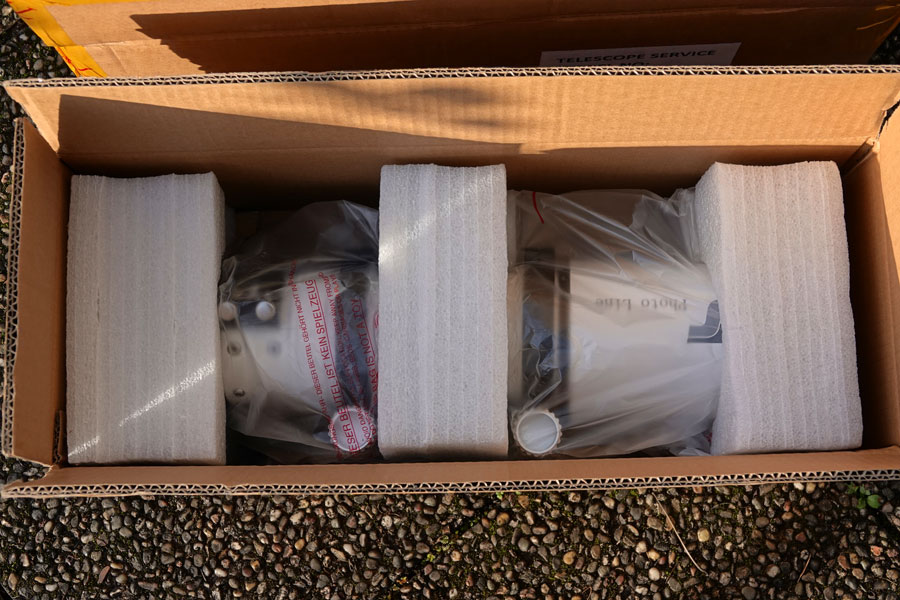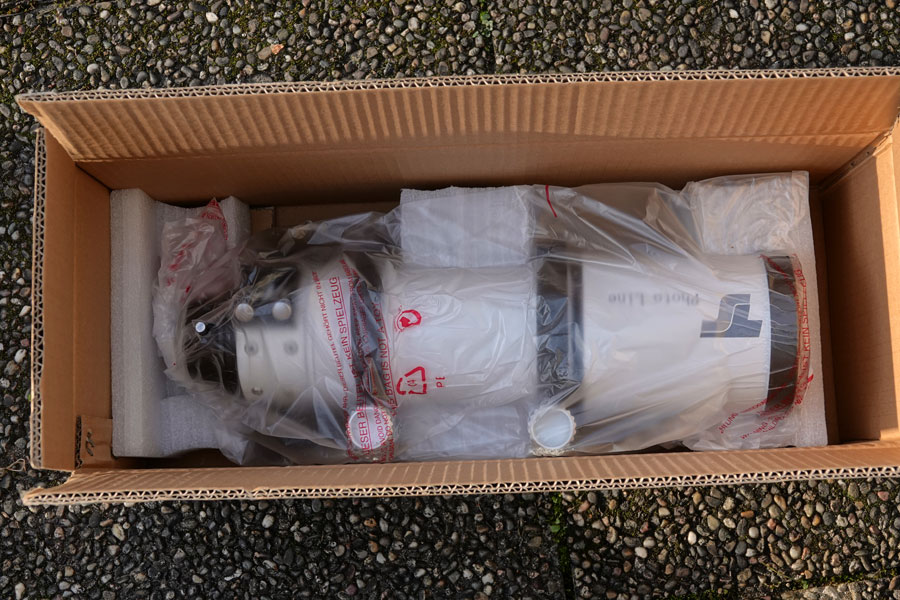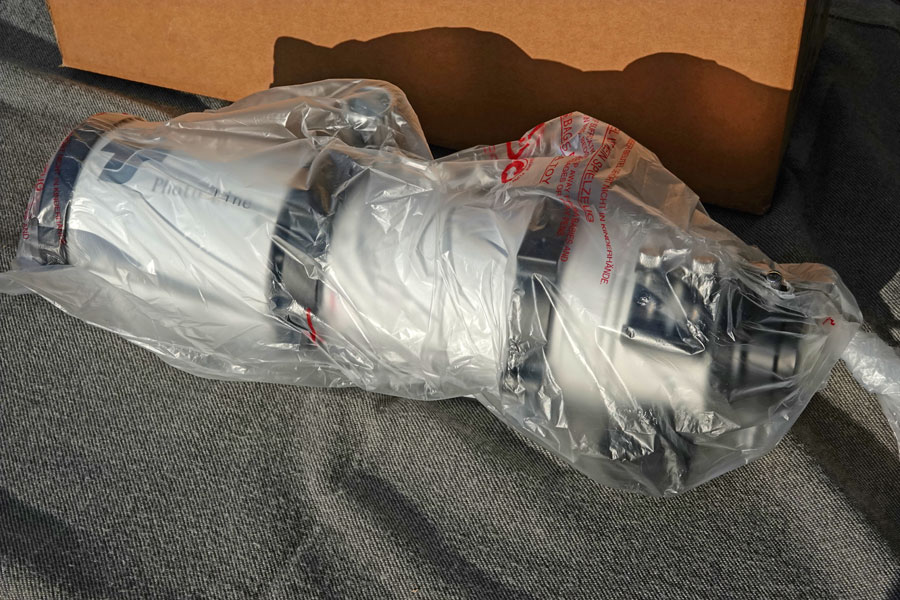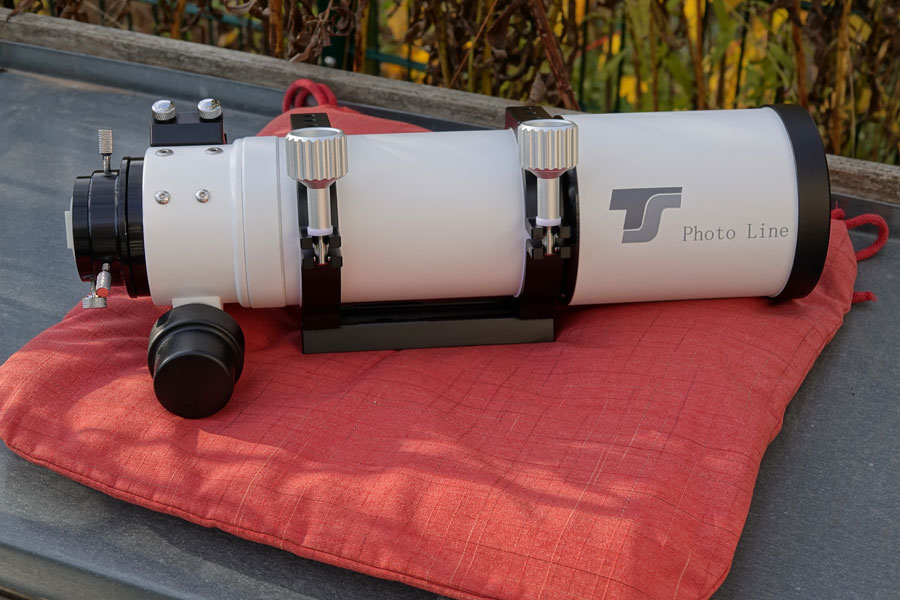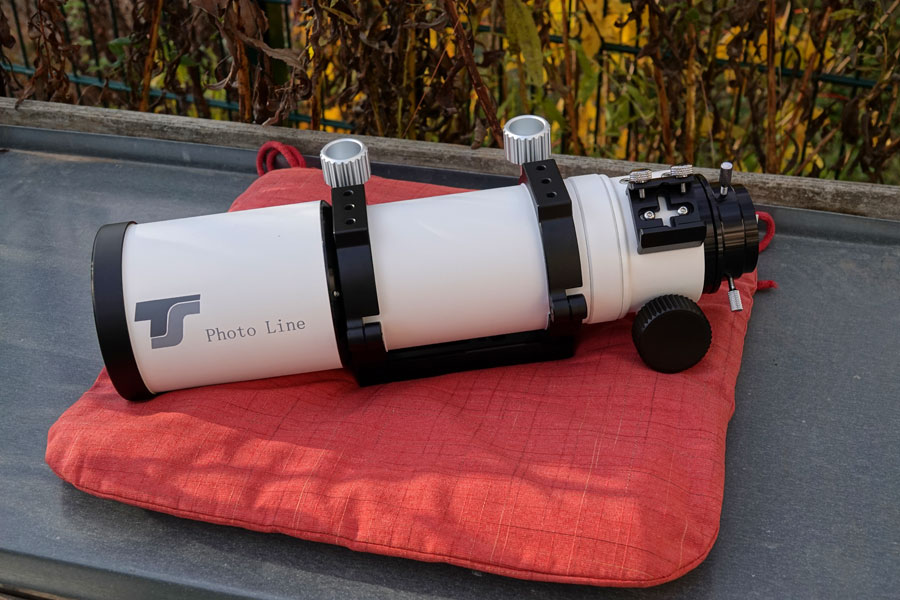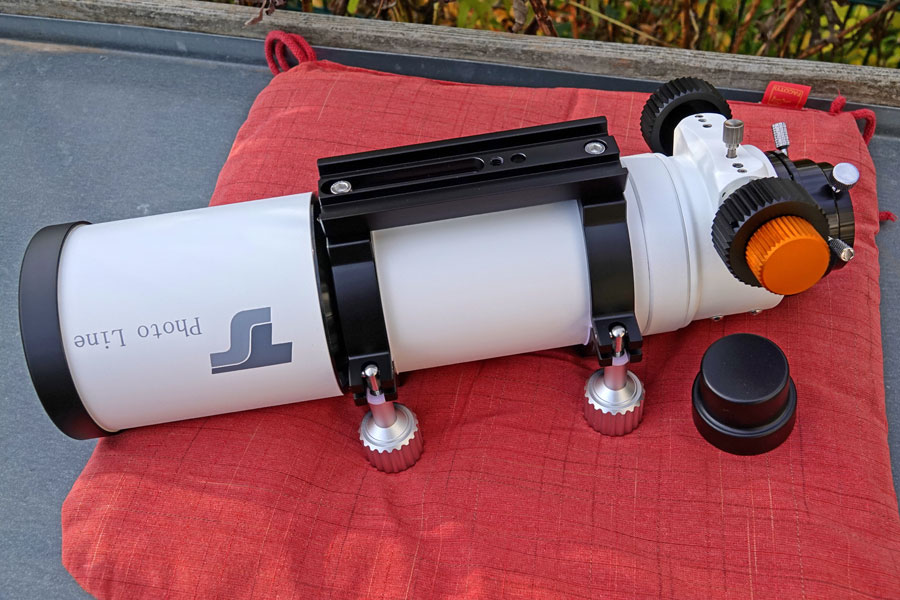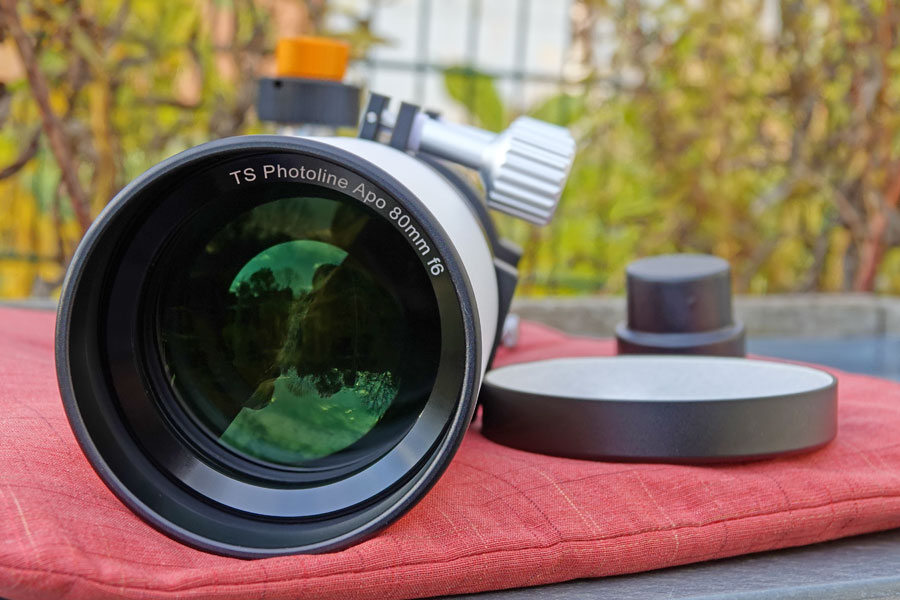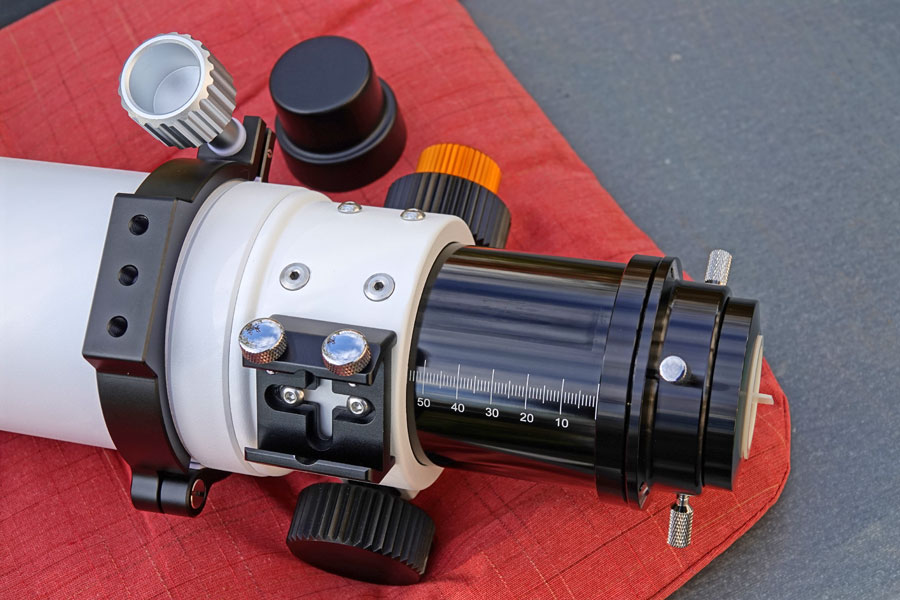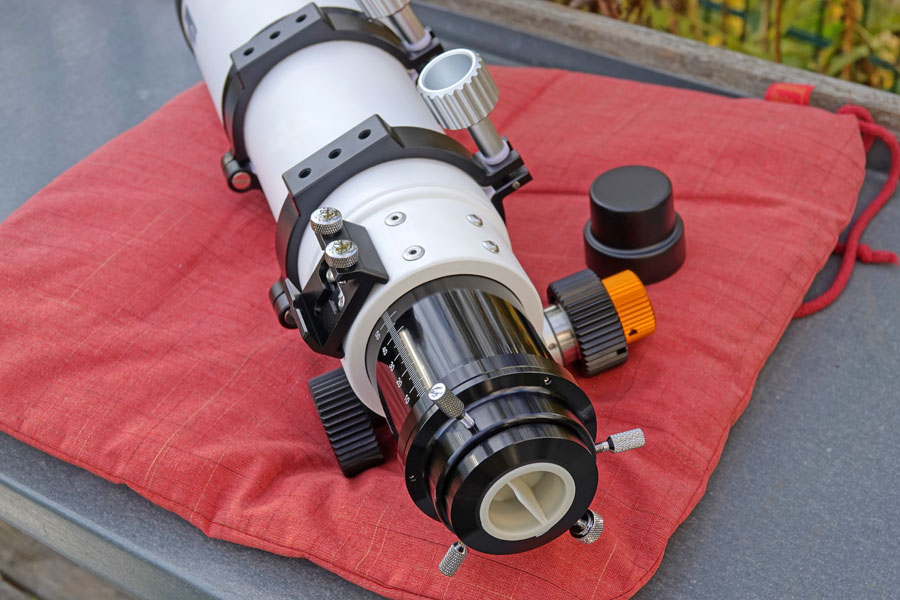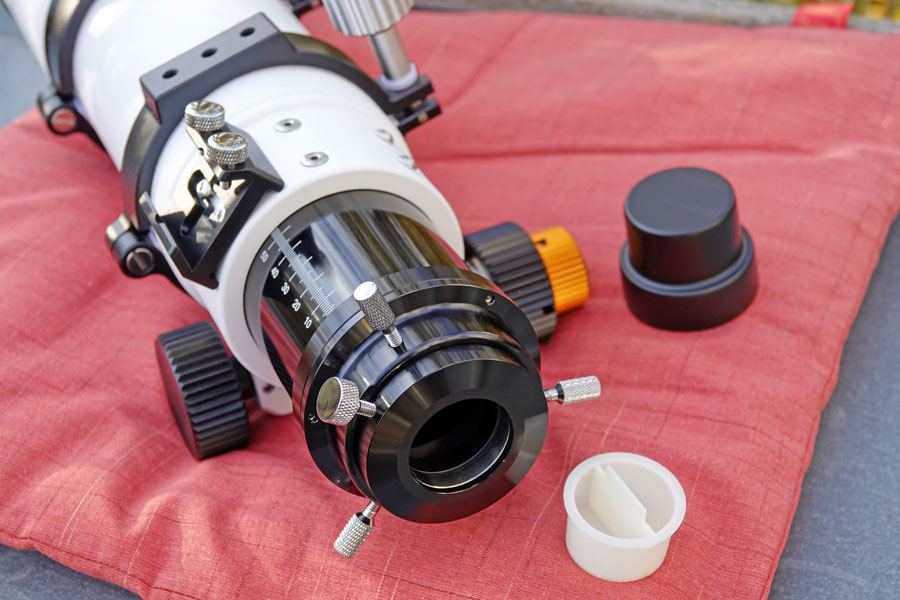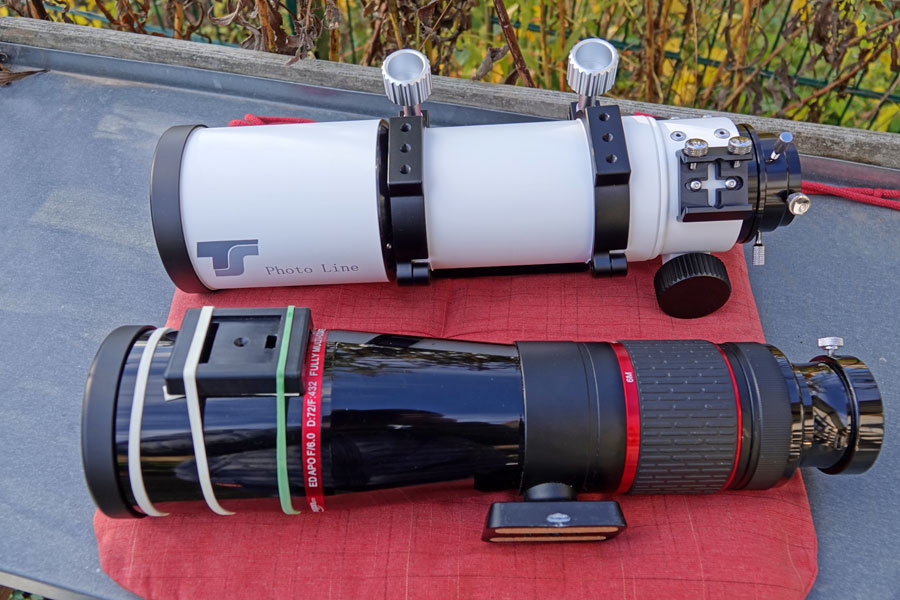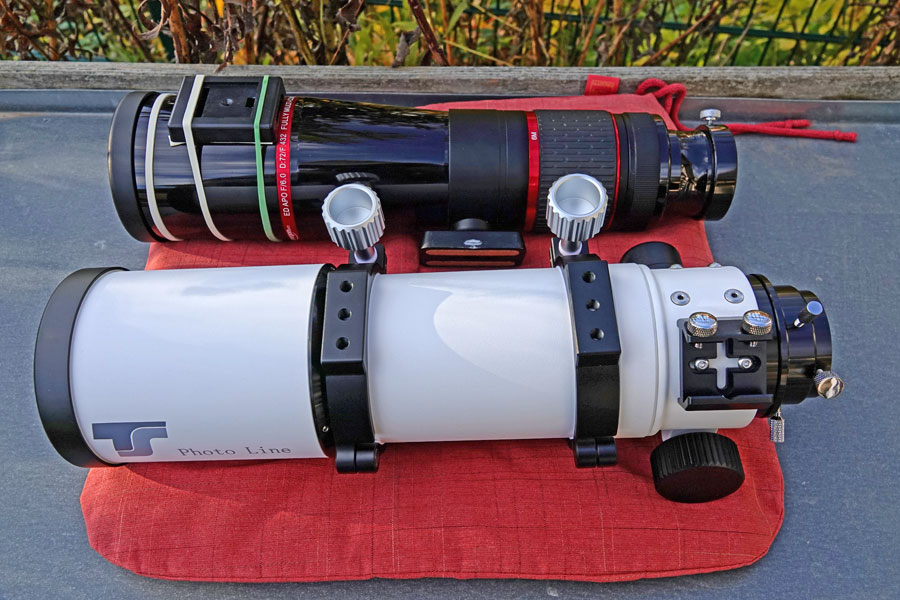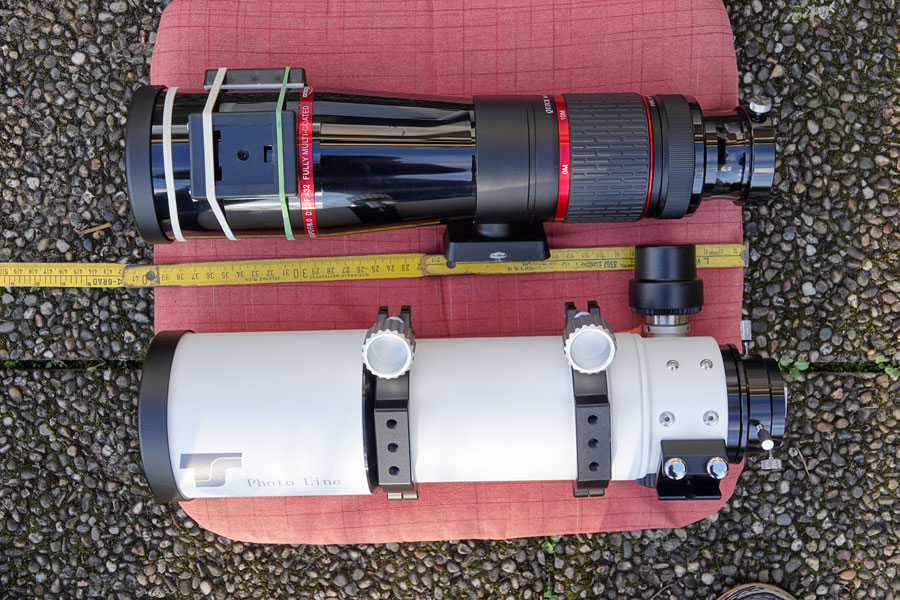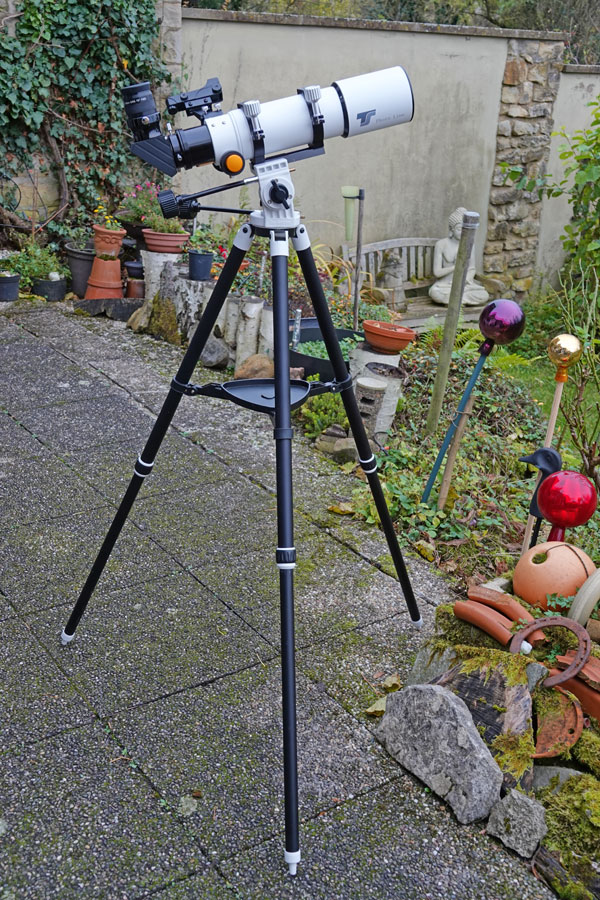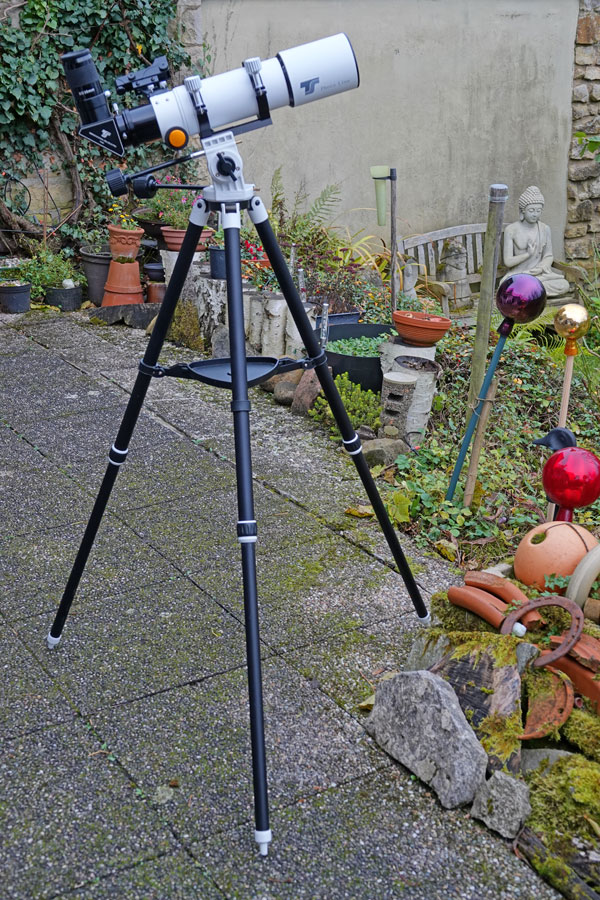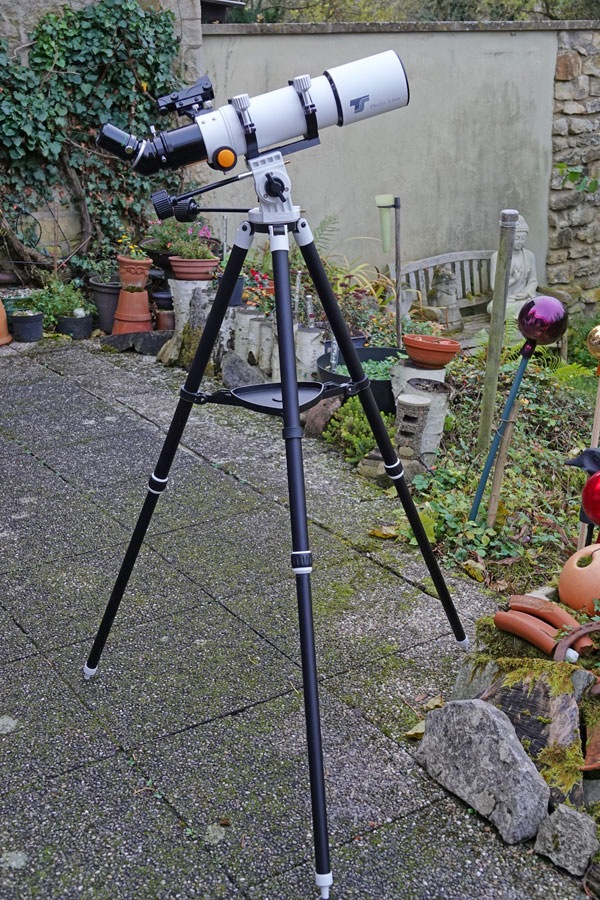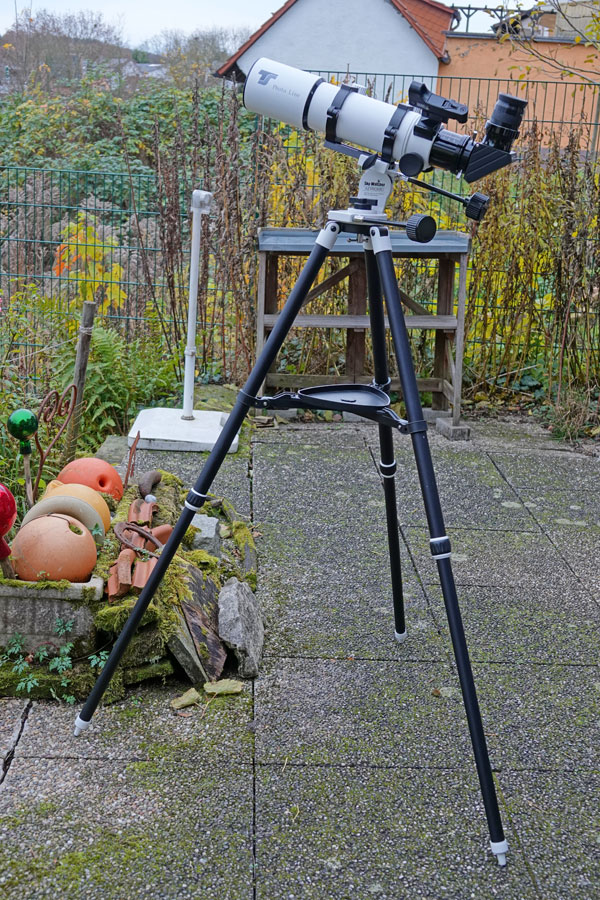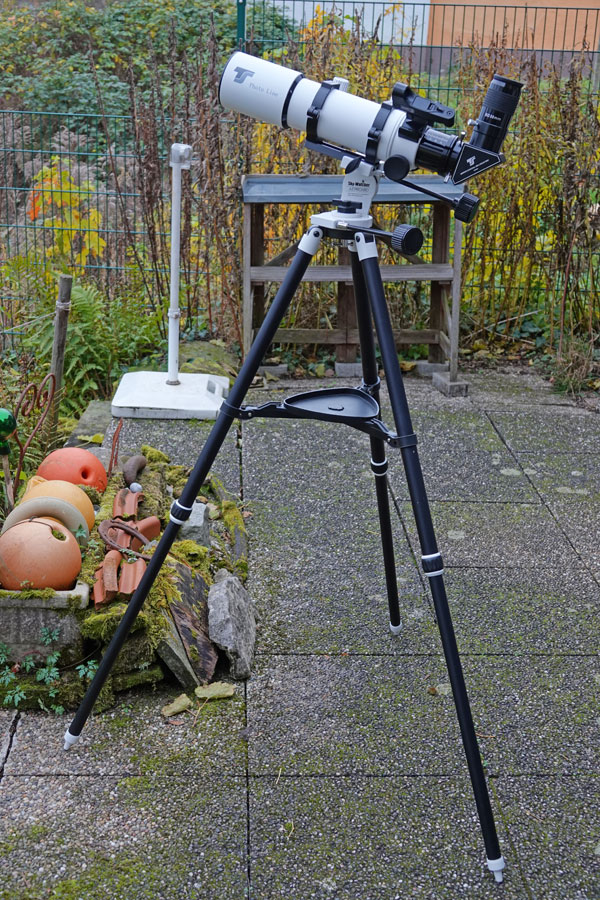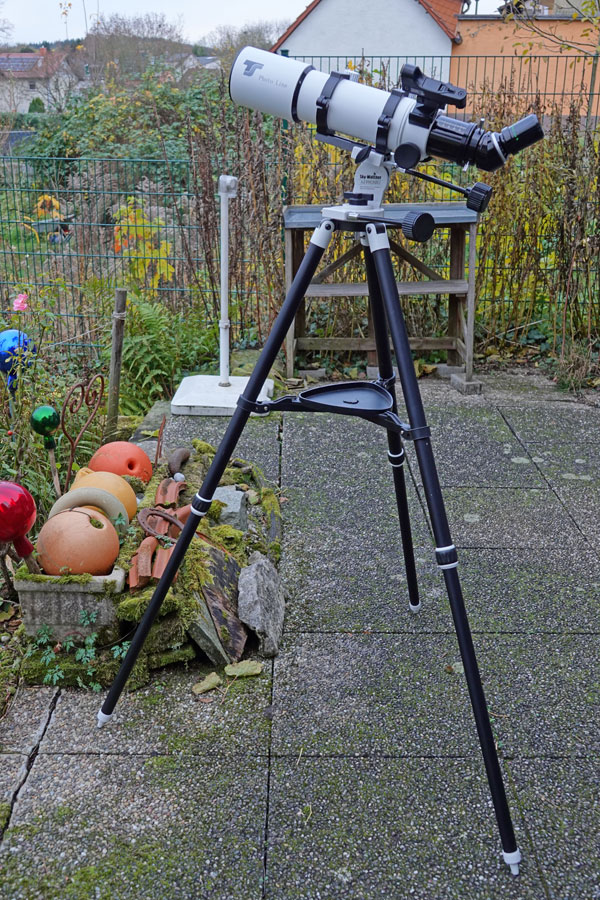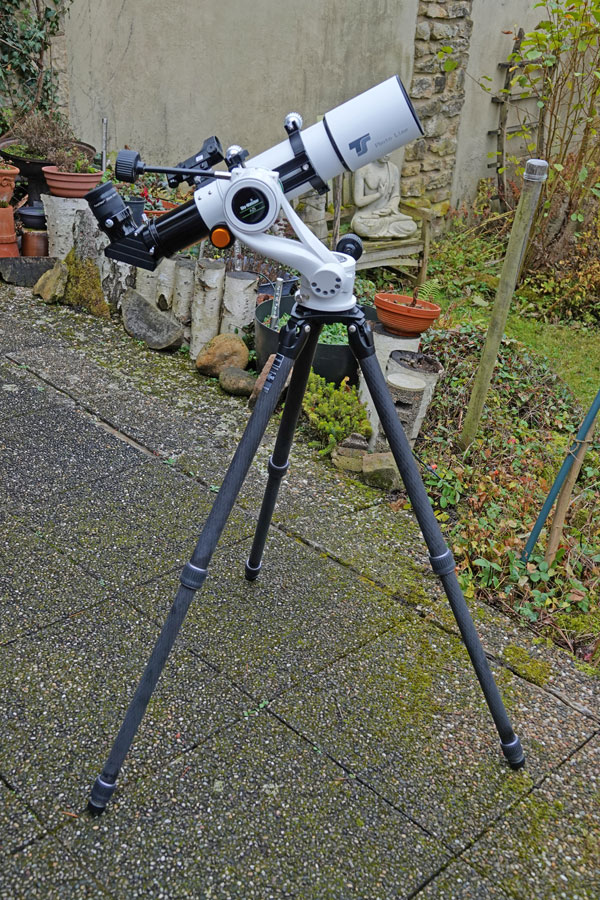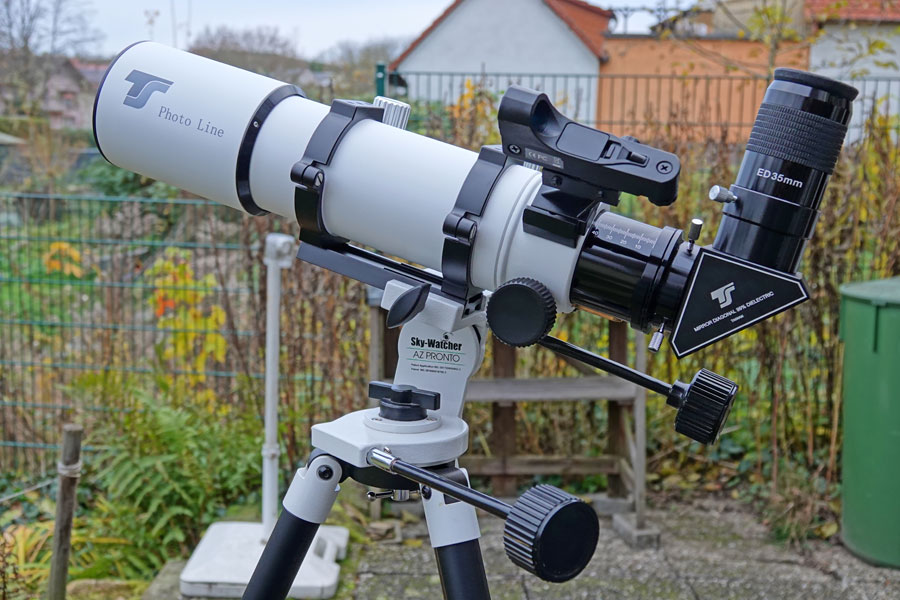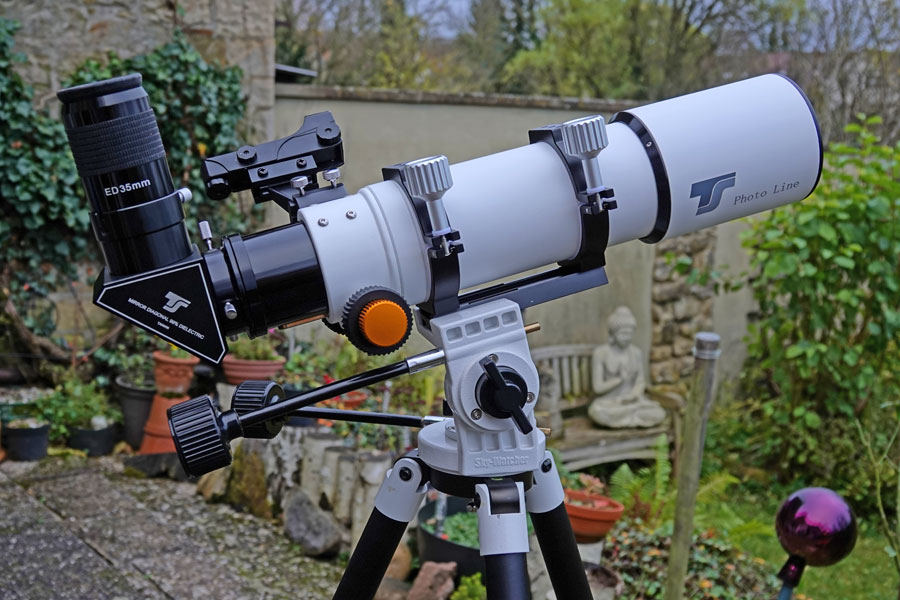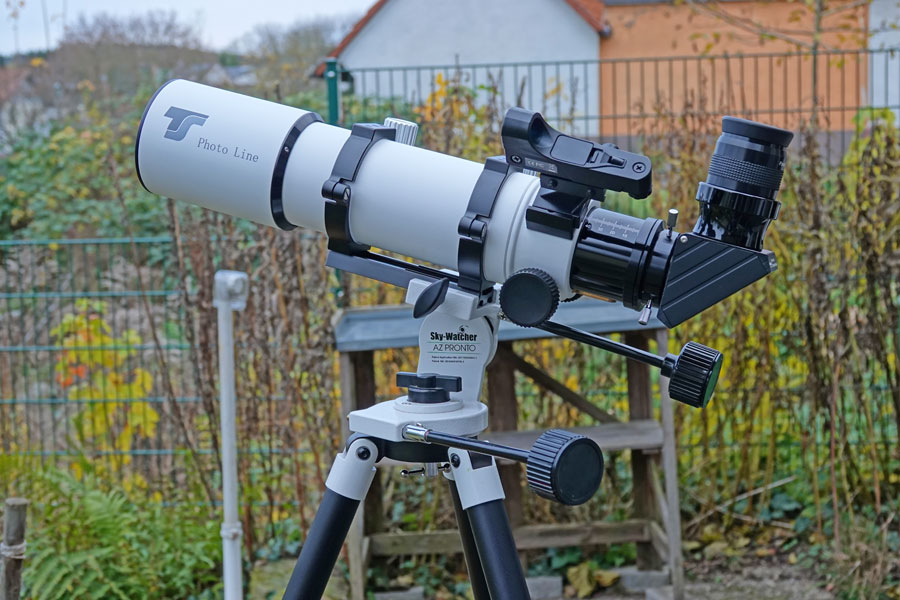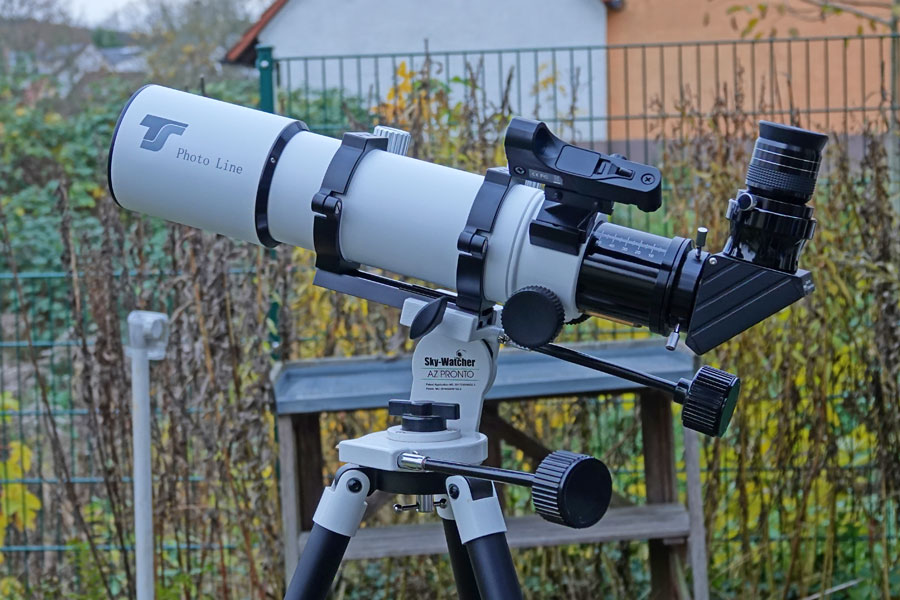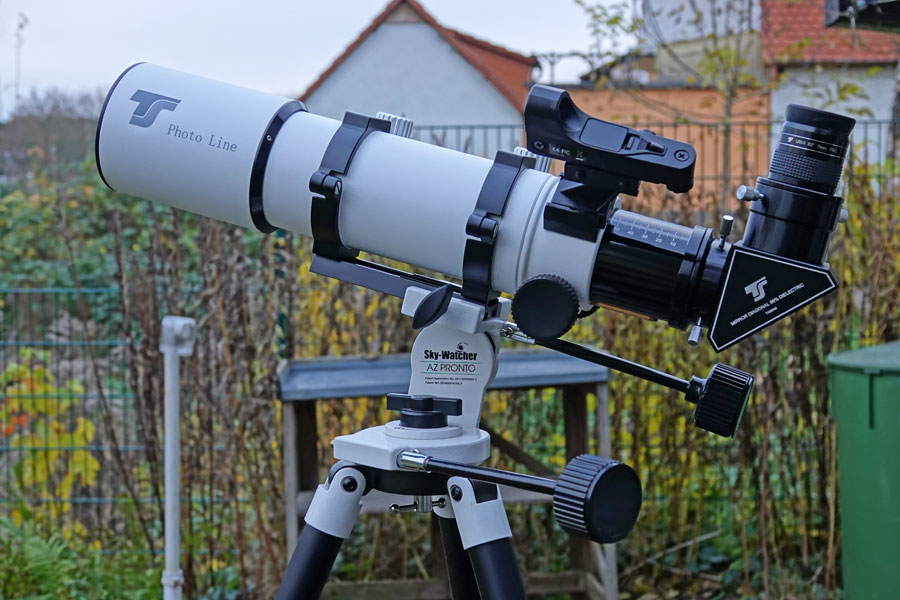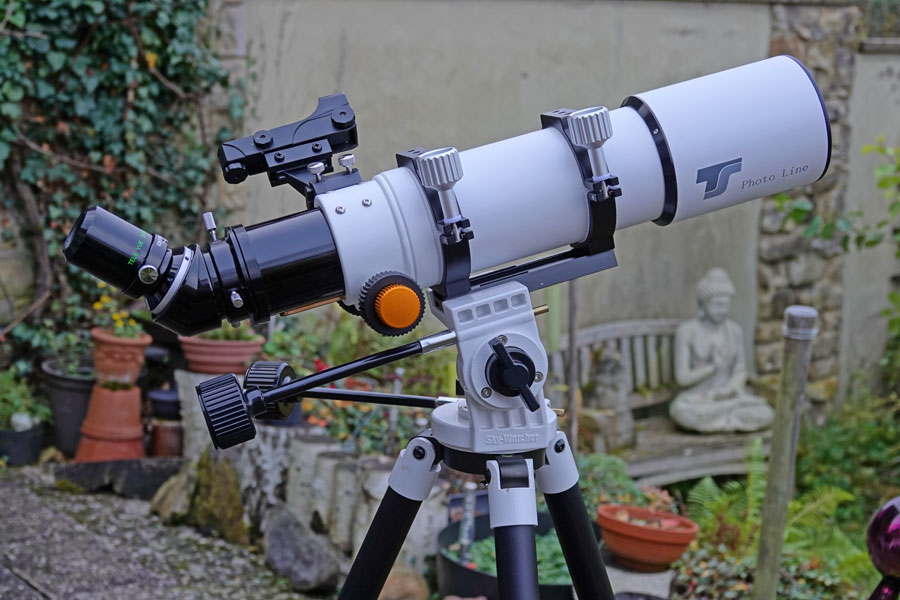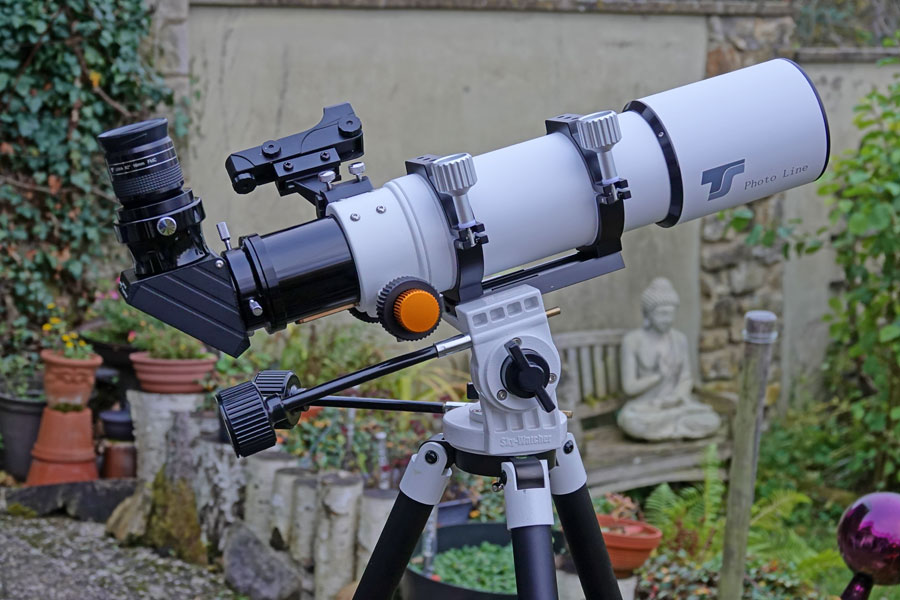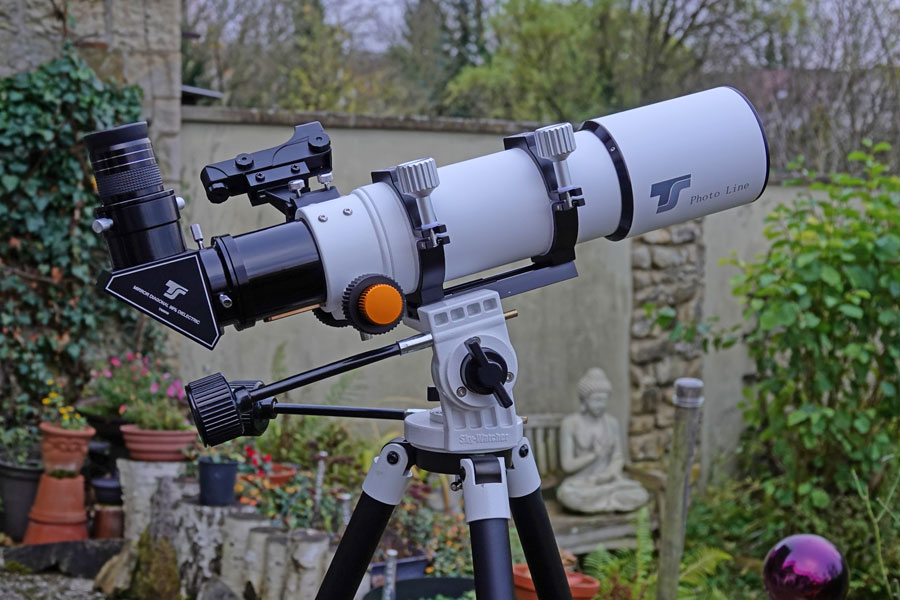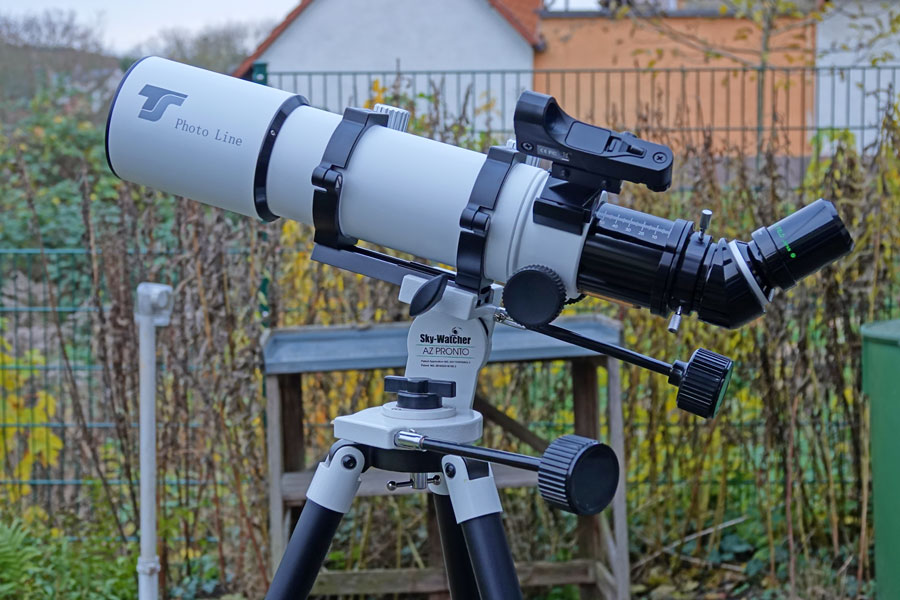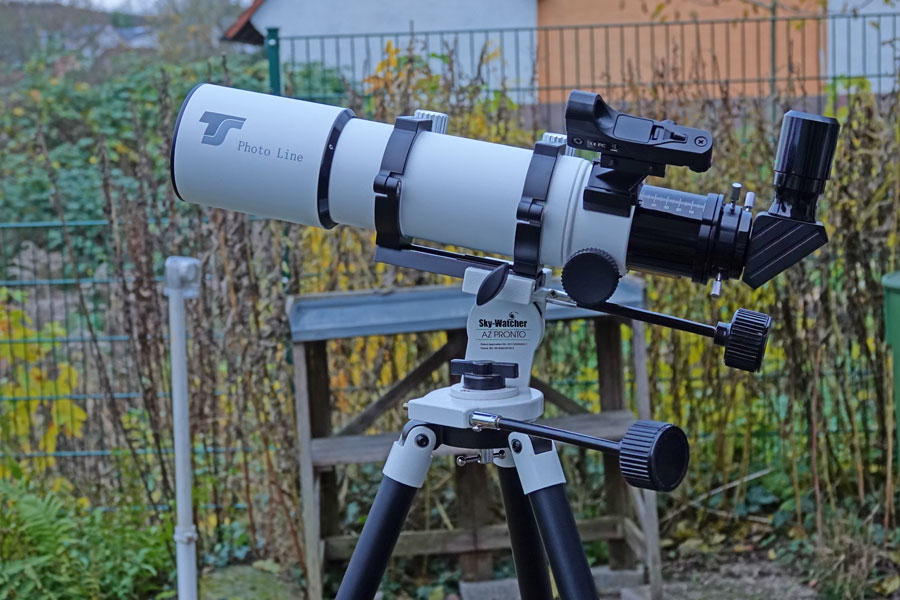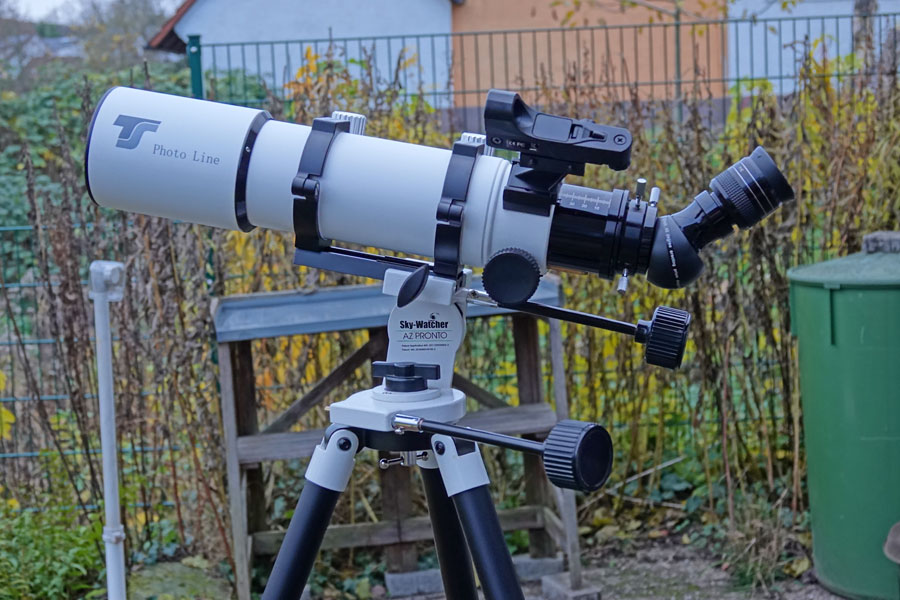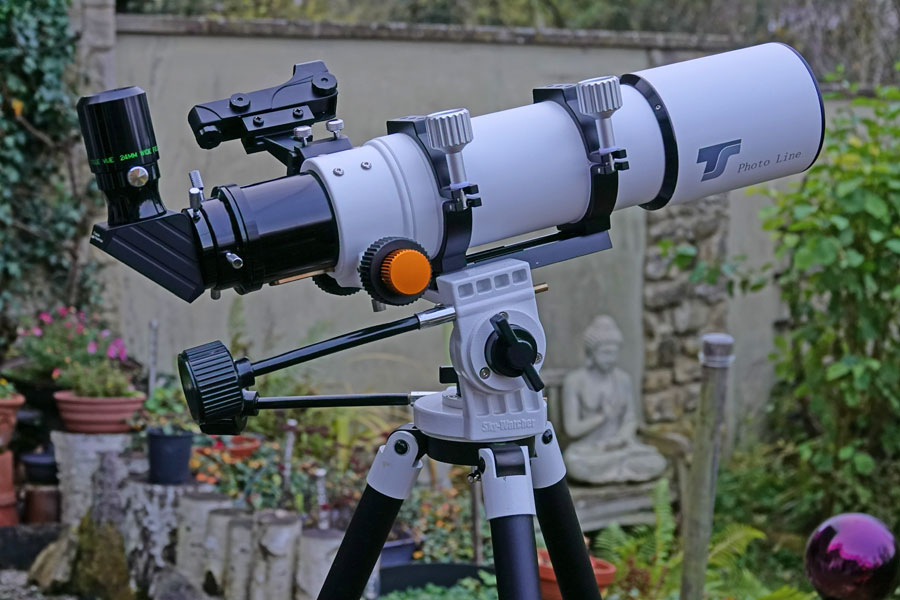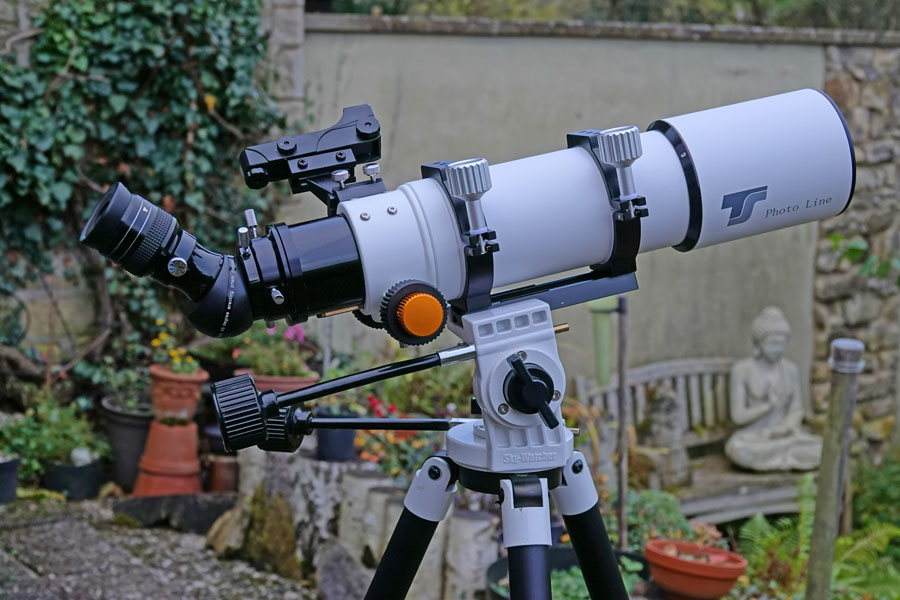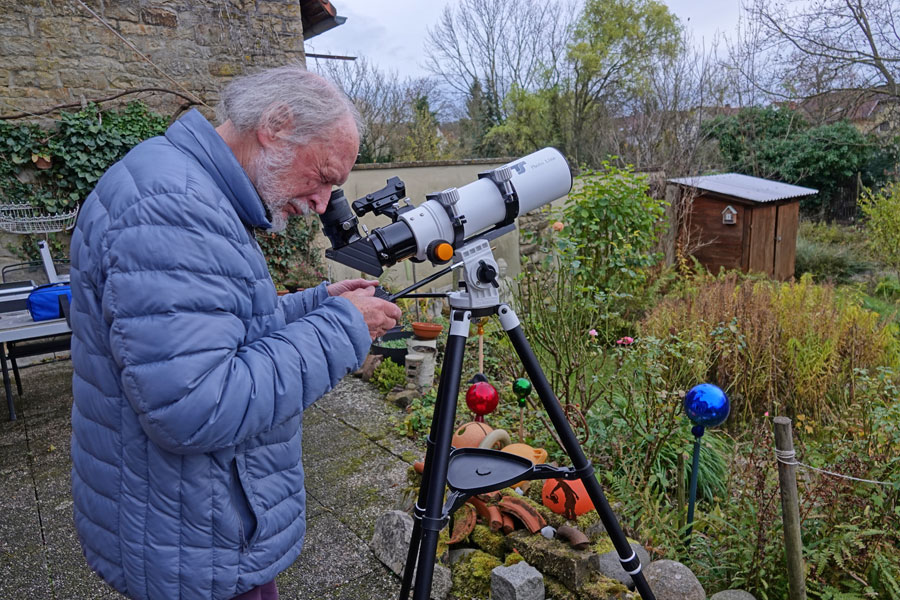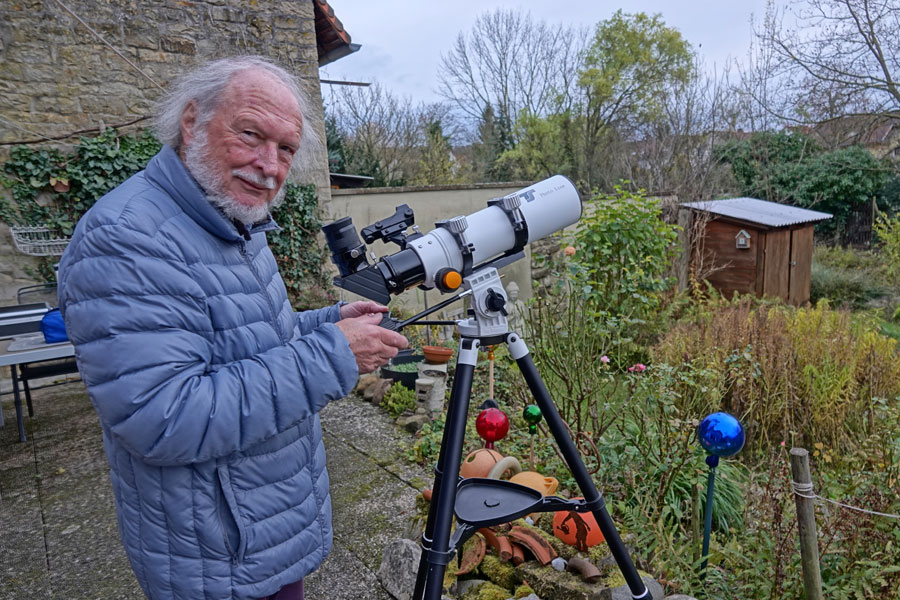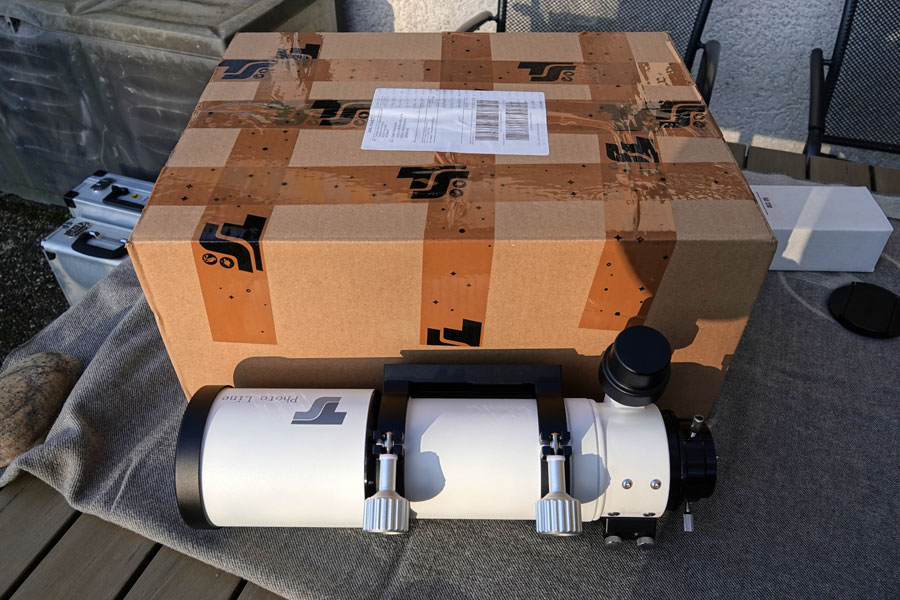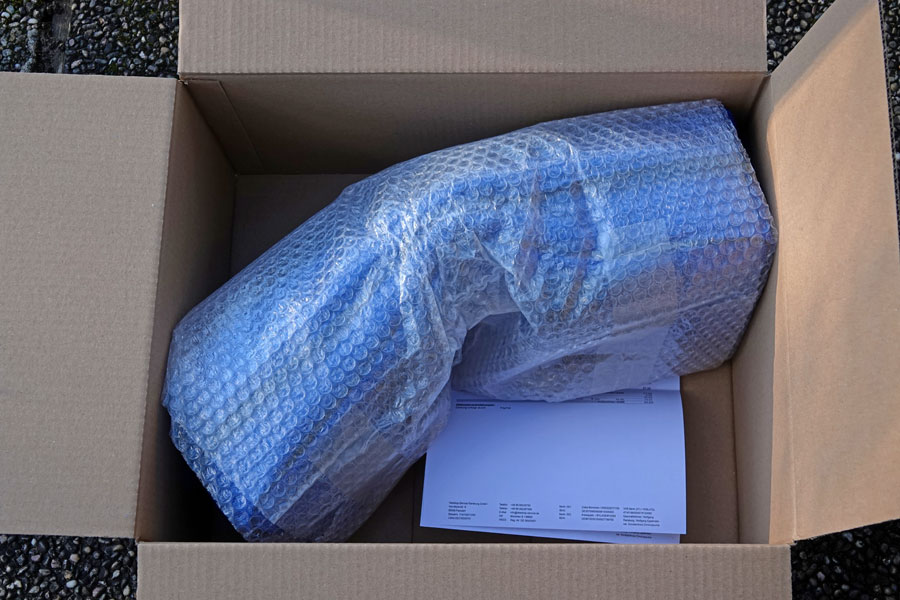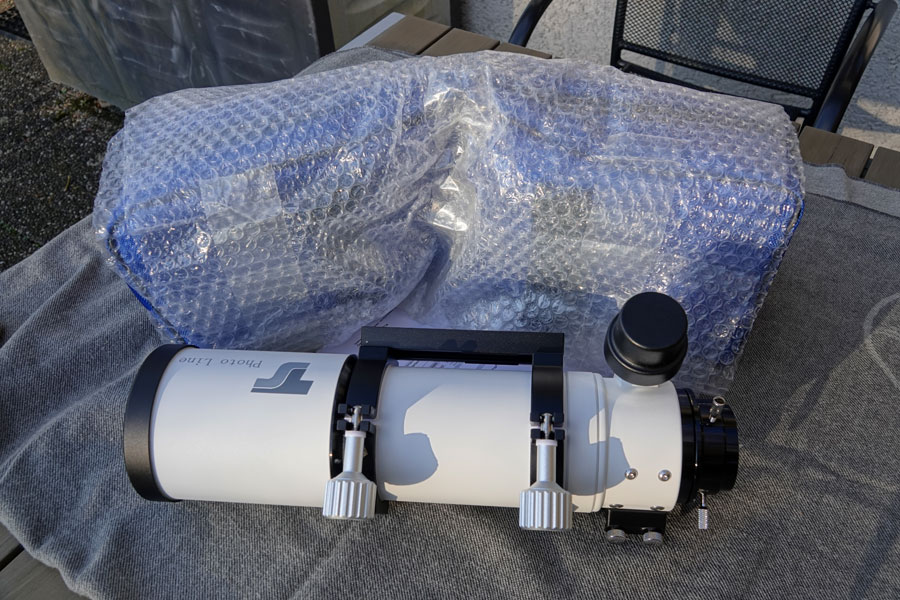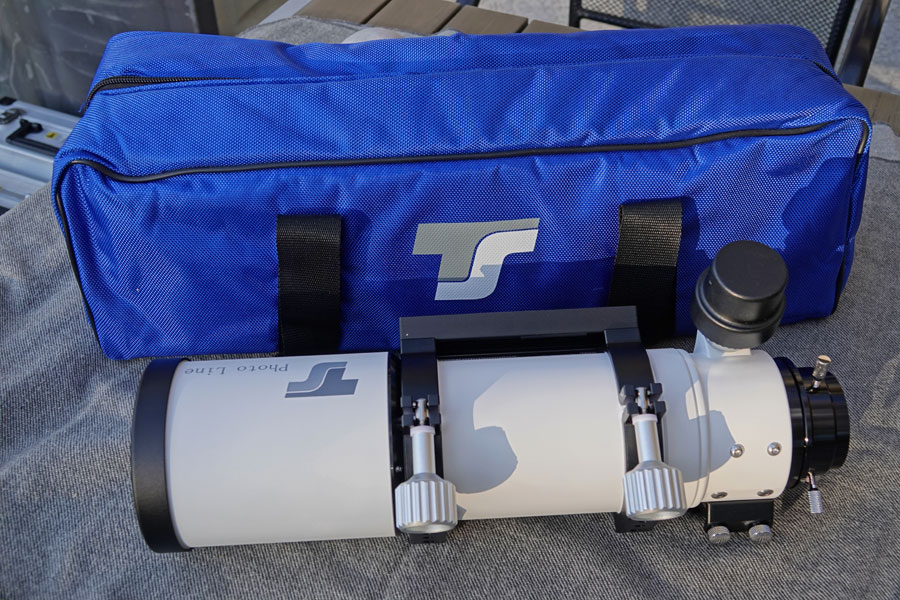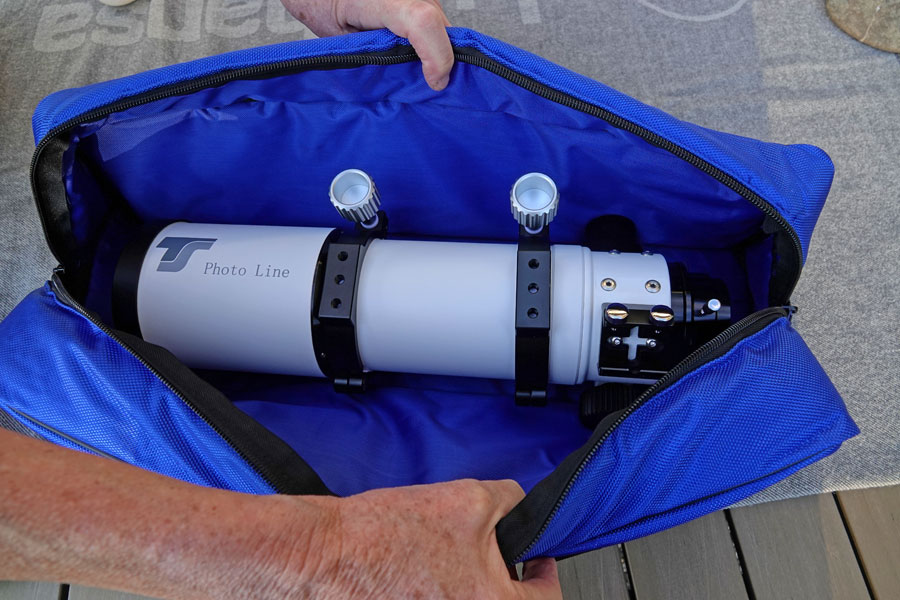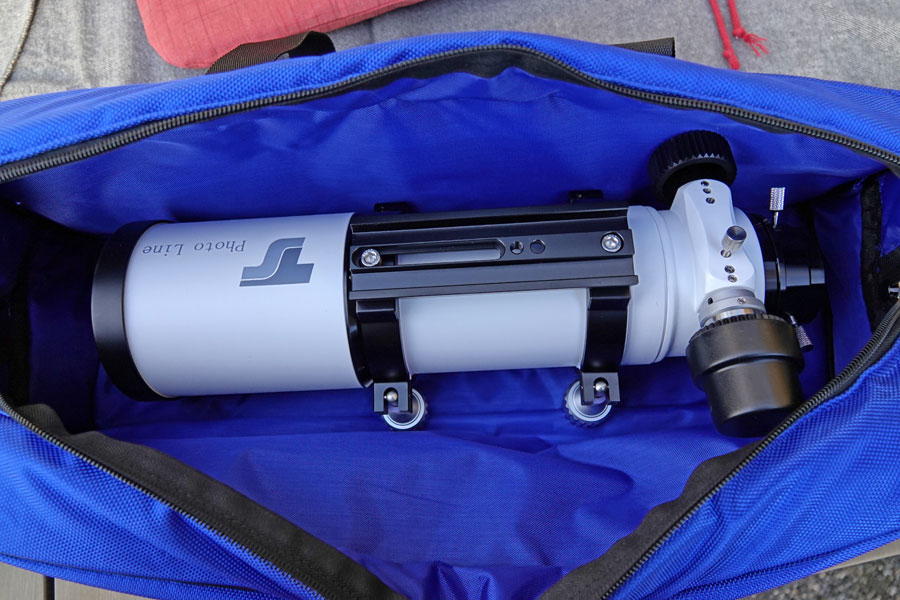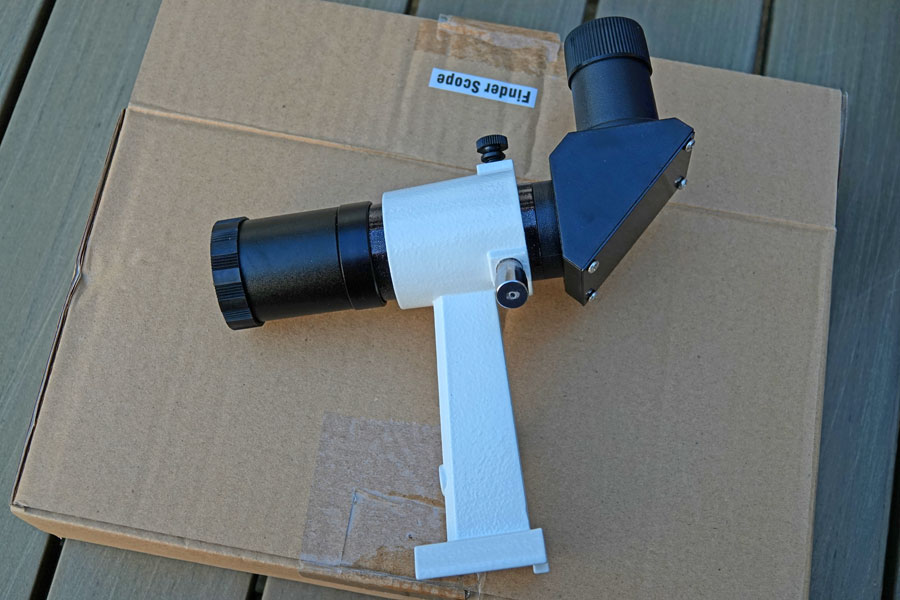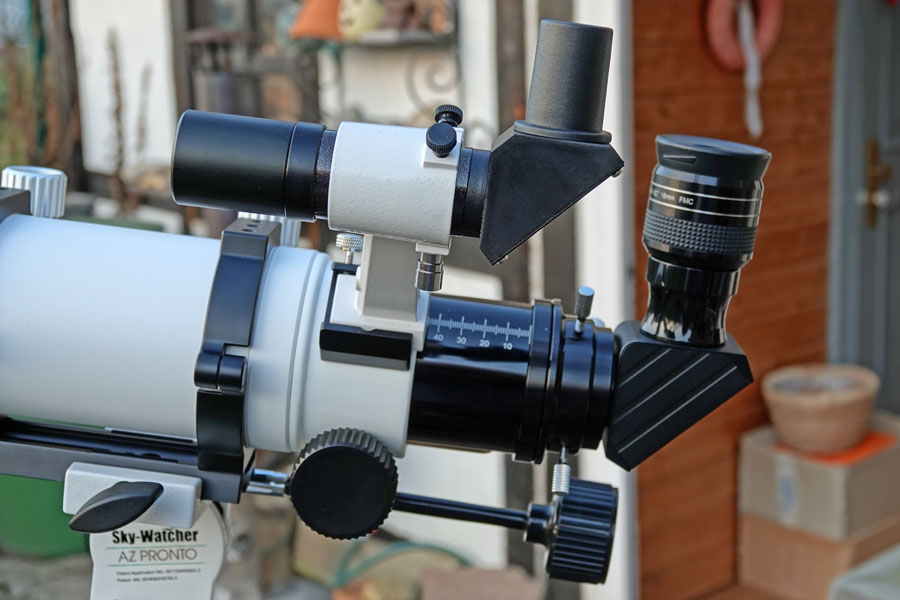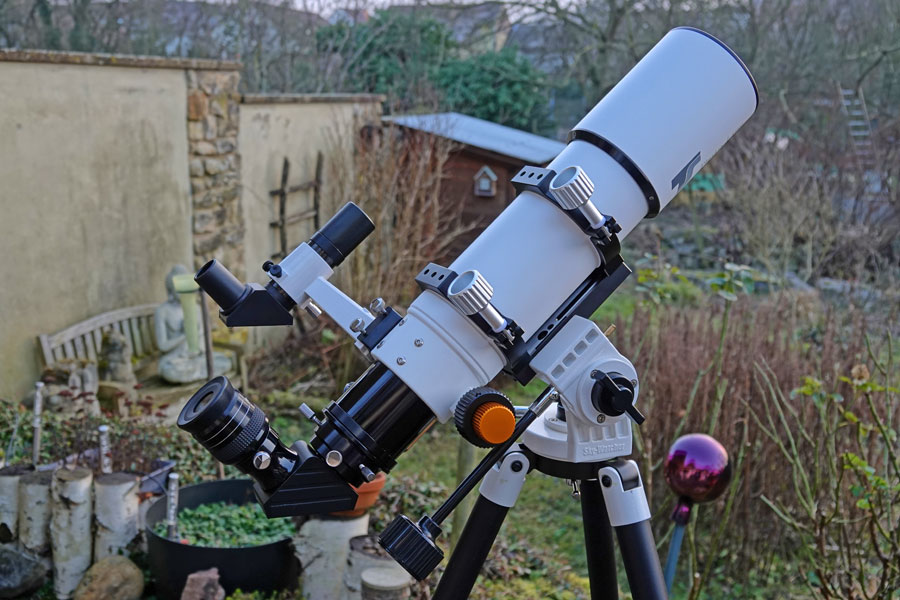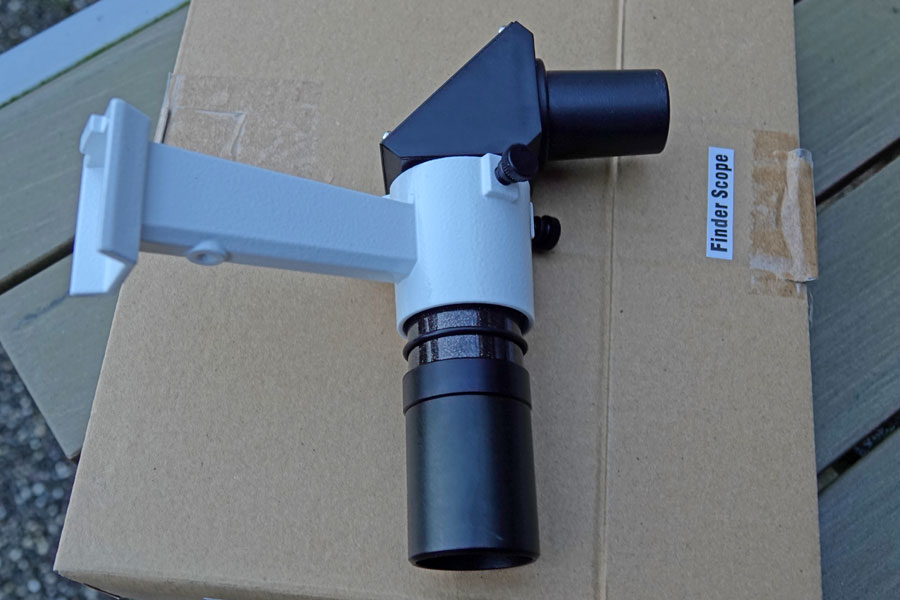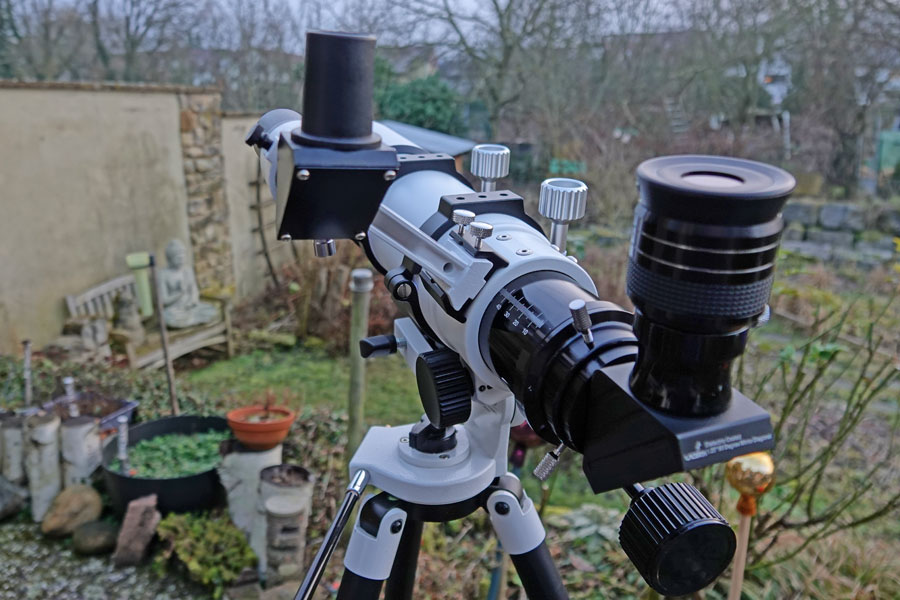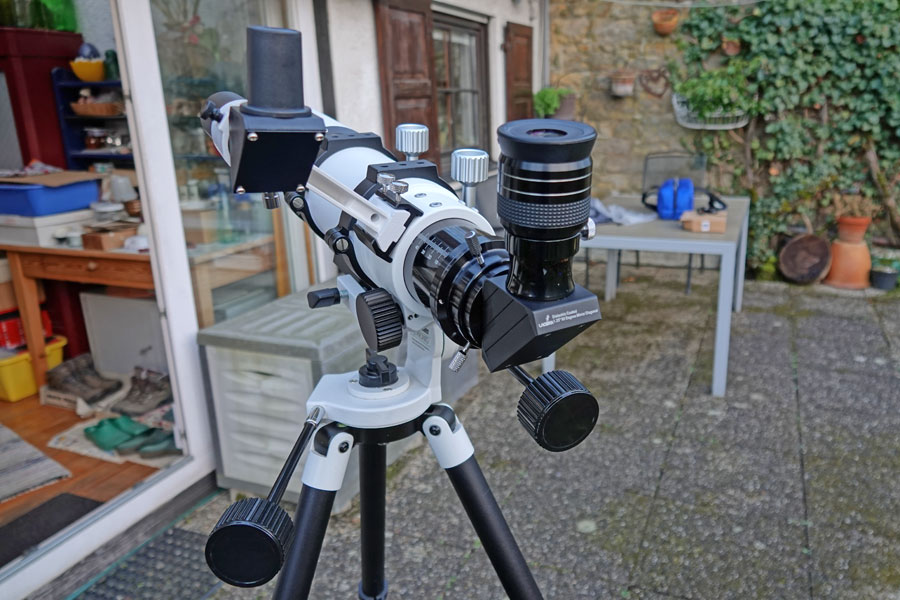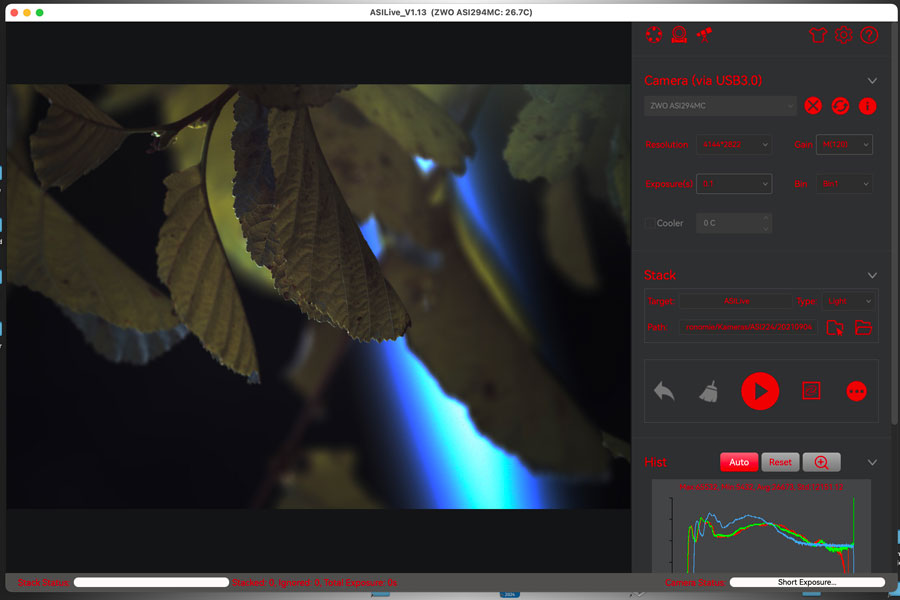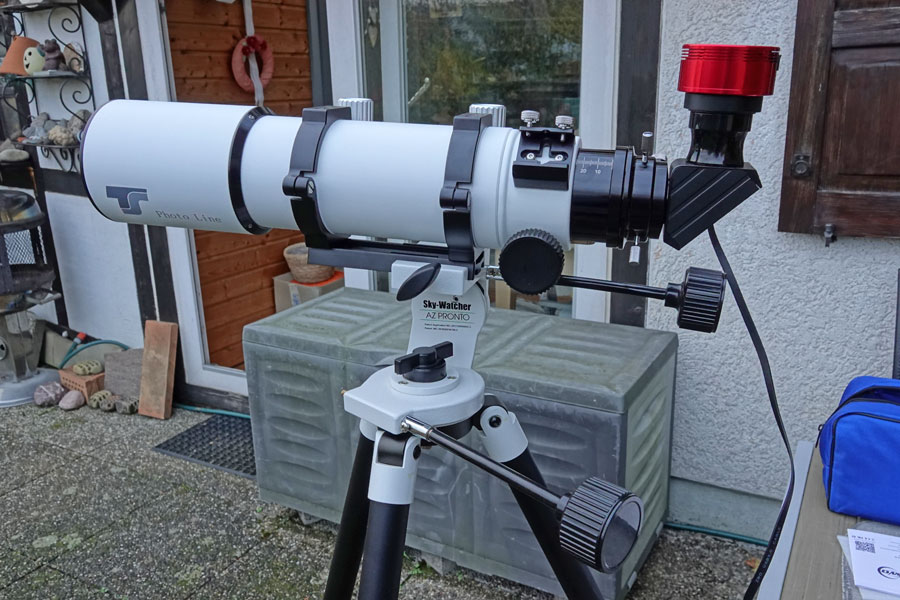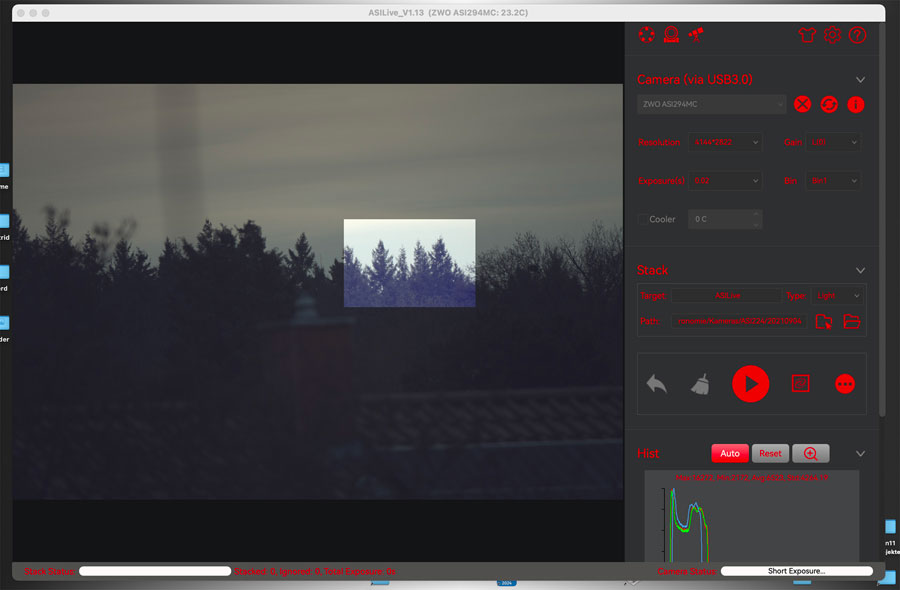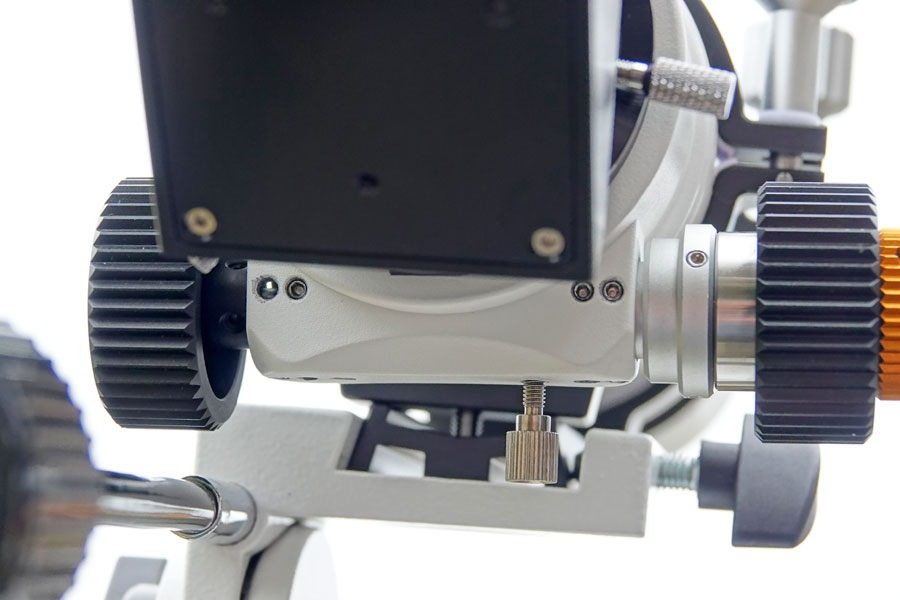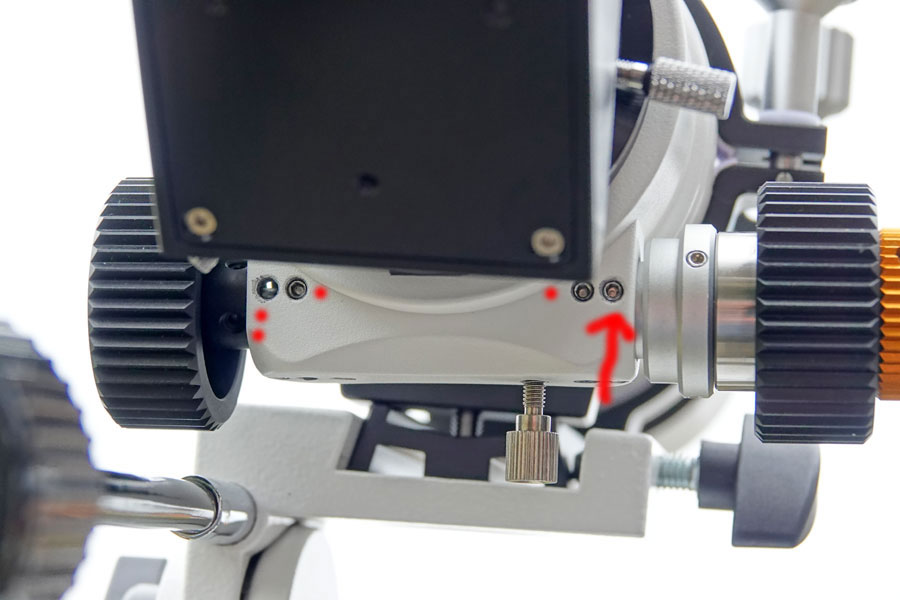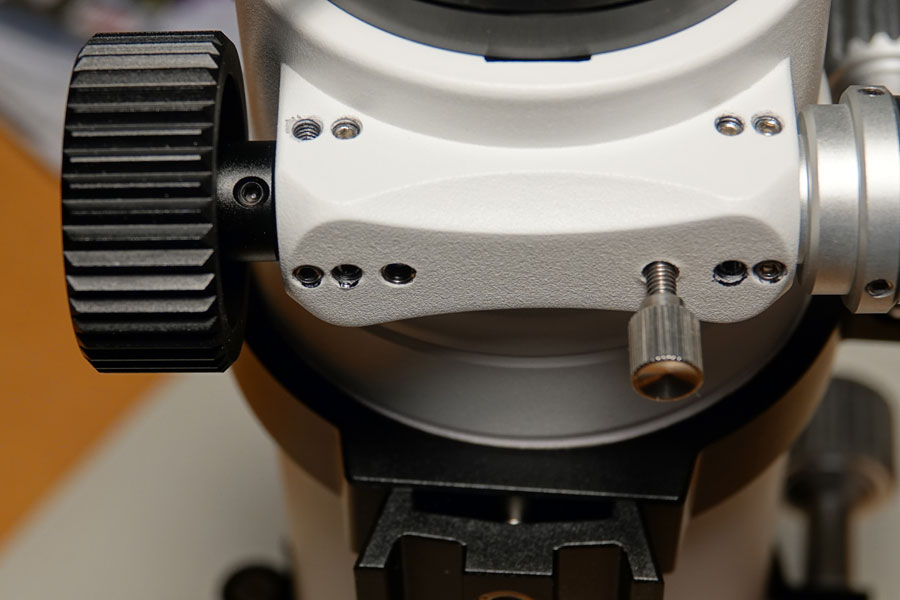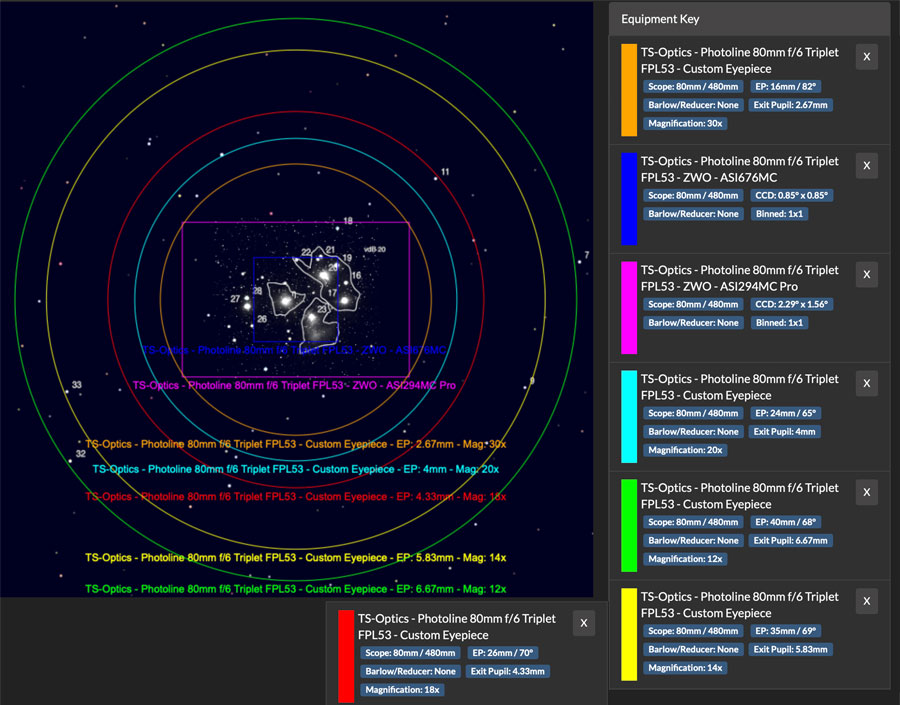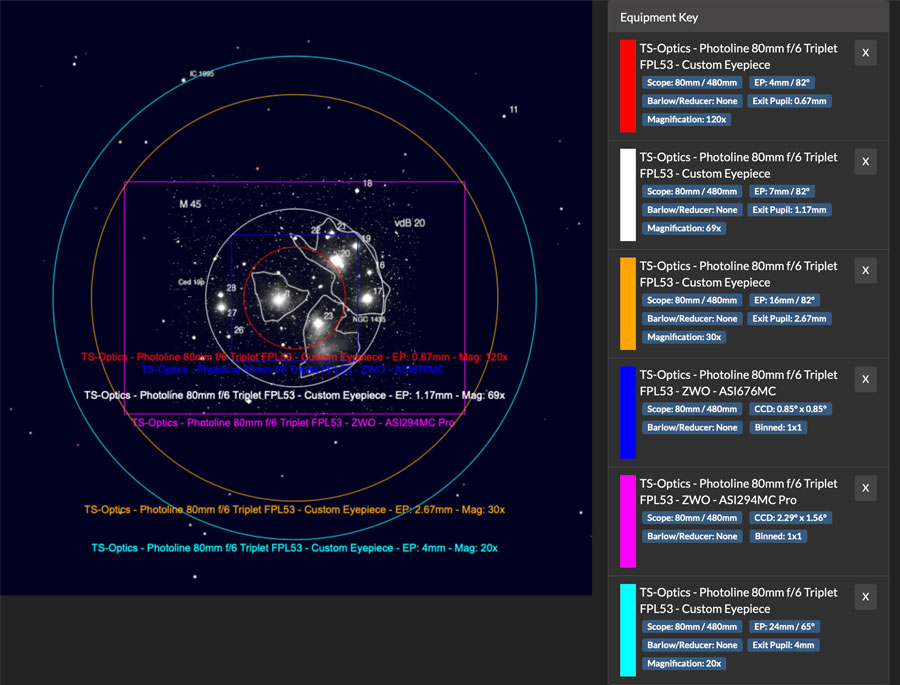TS Optics Photoline 80/480 Information (3.2" Refractor)
Motivation | Look | Visited Sky Objects | First Experiences | Issues and Solutions | First Conclusions | Links | Appendix: Data
On this page I provide some information about my TS-Optics PHOTOLINE 80 mm f/6 FPL53 Triplet APO Refractor - 2.5" RAP Focuser (received on November 20, 2024); the focal length is 480 mm. For simplicity, I will mostly call this refracor (TS-Optics) TLAPO804. I would like to use this telescope for quick-and-dirty visual observations (on the AZ Pronto mount).
See the appendix for the data.
Motivation and Purchase...
Refractors are praised again and again for their sharp and constrasty image, but also criticized because of their color aberrations. Only refractors with very expensive glass seem to be free of color aberrations. And not always seems too be "ED" inside where there is "ED" written on the tube... Although I have no experiences with refractors so far, the praises that I have read have enticed me again and again to purchase one. Every time I found a cheaper refractor on the Internet, I called my astronomy dealer and asked him for his opinion on the respective device. And he advised against it again and again because of the strong color aberrations, so that I for a long time I never purchased a refractor. But at the beginning of September 2018 at the AME2018 astronomy trade fair in Villingen-Schwenningen, I bought one after all, the Omegon refractor PS 72/432 ED (f/6). In July 2020, I then bought a second, larger refractor (TLAPO 102/715, f/7 from TS-Optics, or TLAPO1027 for short), among other because I was not as satisfied with the PS 72/432 as I would have liked. In comparison with the PS 72/432, this three-lens scope was clearly superior. However, as I never had a decent mount for this heavier refractor and therefore did not use it much, I finally sold it in October 2024.
When a starfriend discussed his "refractor situation" with us in November 2024 - should he "upgrade" his 80/480 three-lens tube or buy a ready-made tube with the same optics - the dissatisfaction with my PS 72/432 came up again. And so, quite spontaneously, but with the advice of my wife, I ordered the same refractor that my starfriend then bought (he a second-hand version, I a demonstration model), the TS-Optics TLAPO804. And it arrived just one day after my order!
But the first problems became apparent on the very first day: the focusing had play and we did not like the star shapes. More on this below!
Look
Unpacking |
||
|
Outer box (right) with box for transport bad |
Outer box opened |
Inner box revealed |
|
Inner box |
Inner box opened - another box |
Innermost box pulled outwards |
|
Innermost box remove and opened - telescope tube visible |
Telescope tube in the innermost box |
Ditto, foam removed |
Telescope Tube |
||
|
Telescope tube taken out |
Telescope tube |
Ditto |
|
Ditto |
|
Details |
||
|
Telescope tube from the front
|
Focuser from the side |
Telescope tube from the rear |
|
Telescope tube from the rear |
Telescope tube from the rear, 1.25" adapter removed |
|
Comparison with Omegon PS 72/432
Dew shield not extended for the TLAPO804; the PS 72/432 has a fixed dew shield
Refractor on AZ Pronto Mount (with 2" Accessories)
| With Omegon 2" star diagonal | With TS-Optics 2" star diagonal | With Omegon 2"/1,25" Amici Prism |
Refractor on AZ Pronto Mount Head with Gitzo Carbon Tripod (for Terrestrial Observations)
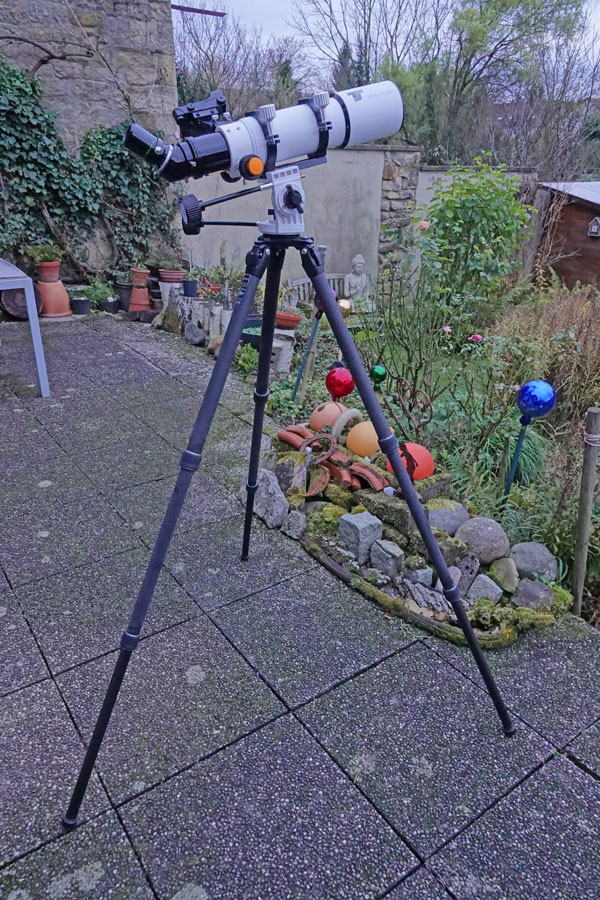 |
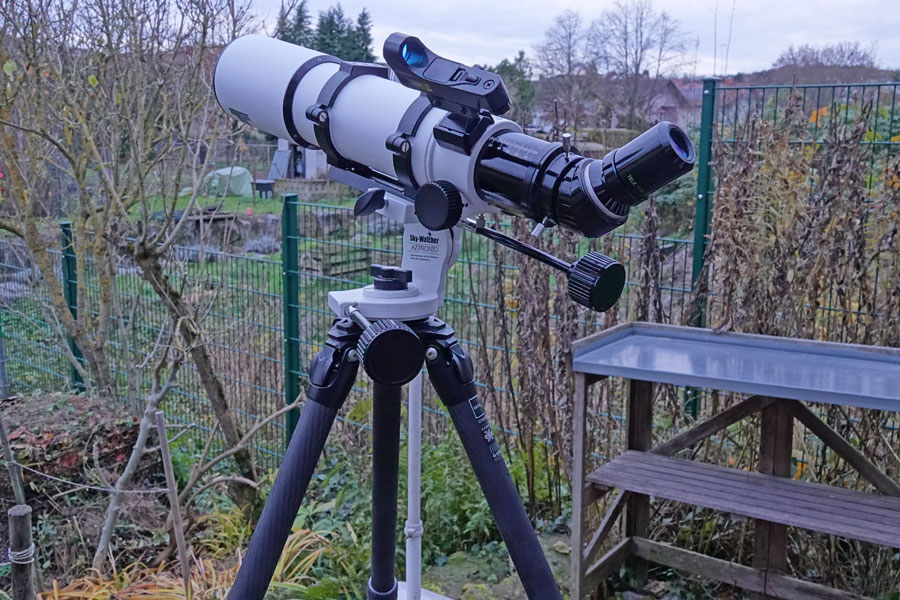 |
TLAPO804 on Gitzo carbon tripod |
TLAPO804 on Gitzo carbon tripod (with AZ Pronto mount head) |
Refractor on AZ5 Mount Head and Gitzo Carbon Tripod
|
TLAPO804 on AZ5 Mount Head and Gitzo Carbon Tripod |
Ditto, side view |
Ditto, other side |
|
Ditto, front view |
Ditto, closer view |
Ditto, other side |
Note: For this mount head, the refractor must be rotated by 90° in its tube clamps!
With 2" and 1.25" Accessories
2" Accessories only
| With TS-Optics 2" star diagonal, 35 mm eyepiece | With TS-Optics 2" star diagonal, 35 mm eyepiece | With Omegon 2" star diagonal, 26 mm eyepiece |
1.25" Eypieces at 2" Accessories
| With Omegon 2" star diagonal | With TS-Optics 2" star diagonal | With Omegon 2"/1.25" Amici prism |
1.25" Accesories only
|
||
|
||
| With Lacerta 1.25" star diagonal | With Baader 1.25" Amici prism |
The Telescope and its Owner
|
Carrying Case for TLAPO804
The TLAPO804 does not come with a carrying case. Therefore, I ordered a case from TS-Optics for the tube (but only after having ordered the refractor...). It arrived on the same day as the tube, so I was able to try it out straight away.
|
The best fit! |
In the meantime, I protect the tube with the bubble plastic in which the bag was wrapped.
Visited Sky Objects
My first observations took place at the ende of November 2024. Due to poor observing conditions, I initially only "explored2 the area around Altair (Aquila) and a few other brighter stars (it was all about the star images).
On the first day with better skies (Nov 29, 2024), I visited/searched for the following celestial objects: Coat Hanger CR399, Dumbbell Nebula M 27 (nearby, found it more by chance); I could not find M 71, but the small constellation Sagitta, in which M 71 is located. After a break, I visited/searched for the following celestial objects: M 42, M 78 not found, Pleiades M 45, Hyades Mel 25, Jupiter, Mars, M 42 with higher magnifications (much more to see, eyes better adapted), M 15 not found.
On January 18, 2025, I observed the Orion Nebula M 42, the Pleiades M 45, and the Hyades Mel 25, as well as Venus and Saturn (individually and also together, because they were only a good 2° apart) and Mars (small disk).
Further Observations will be described elsewhere.
First Experiences
Ugly Stars
During "First Light", I noticed that brighter stars were not round, but had a wide variety of shapes and some of them did not look nice at all. I had never noticed this in the past. However, I had not done much visual observing recently, so my memory was no longer the freshest. So I searched the Internet to see if I could find out more about this. The search was not very fruitful in that all possible causes for "ugly" stars were discussed, such as spikes caused by the suspension of the secondary mirror in Newtonian telescopes, but less so my question of whether it could also be due to the eyes. It obviously can. Especially muscle fibers (for accommodation) seem to cause diffraction which deforms the stars. I also have two artificial lenses after two cataract operations, which might also be responsible for the ugly star shapes.
I then compared three different refractors*, although I was only able to see one star at a time and with fluctuating brightness due to poor skies. This made the comparison difficult... In the end, after this comparison, I came to the conclusion that the poor star shapes were probably actually caused by my eyes, because all refractors showed similarly shaped stars, whereby the shapes can change greatly depending on the view and focus. The role of the eyes in the star shapes was also supported by the fact that the stars looked different in both eyes. My wife has astigmatism in both eyes and saw considerably less attractive stars than I did.
*) At the moment I have an older version of the TLAPO804 from a star friend at my disposal. The third refractor is my Omegon PS 72/432.
The big question ultimately is, whether a good (and therefore expensive) refractor is worthwhile at all if you only want to observe visually and your eyes cause poor star shapes... I will have to think about that!
"Jagged" Blurring
When I tried out the telescope for the first time during the day with 2" eyepieces on trees opposite our property, I noticed that thin branches became "jagged" when I put them out of focus. Unfortunately, I cannot show a photo of this here. When I then tried the same thing with 1.25" eyepieces, the branches became blurred as expected. I was also able to confirm this effect on the older model of the TLAPO804, which is currently at my disposal (I have not yet tried this out on the PS 72/432). Strange!
Finder Shoe, Red Dot Finder, Angle Finder
My Omegon PS 72/432 refractor was delivered without a finder shoe, and I could not find a way to mount one. The dealer advised me to use a Rigel finder whose finder shoes can be glued on, which I then did. My TLAPO1027 refractor was also delivered without a finder shoe, but it had screws on the focuser that could be used to mount a finder shoe (slotted hole method). That is what I did. In contrast to older versions, my new TLAPO804 refractor was delivered with a finder shoe. At the moment, I use an existing red dot finder, but for stars near the zenith an angle finder would be more practical so that I do not have to "crawl under the telescope".
| Finder shoe on the focuser | Red dot finder installed... | Ditto |
Unfortunately, there are no light point angle finders. So I had to resort to a magnifying finder, which I bough in December 2024. I chose a version that shows the sky upright and non-reversed, just like a normal LED red dot finder does.
|
Sky-Watcher angle finder |
Angle finder on the telescope |
Ditto, seen from the other side |
|
Angle finder pushed forward. The rubber ring that locks the finder in its holder is now exposed, and the viewfinder can be rotated |
The angle finder was turned and now points upwards |
Ditto |
In the packaging, the angle finder is aligned in the same way as the finder holder (see photo on the left). However, as the finder shoe is at an angle of about 45°, the angle finder must be rotated in the finder holder so that it points vertically upwards. However, this did not work for me at first because the viewfinder is locked in the holder by a rubber ring. You therefore first have to push the finder forwards to push the rubber ring out of the holder, then turn the finder accordingly and finally push it back again so that the rubber ring can lock in place again. Sounds more complicated than it is, but it probably has to be repeated every time the angle finder is used, as does the adjustment of the finder. This is of course cumbersone! In the case that the refractor is to be used on the AZ5 mount head, the finder has to be turned in the same direction, because the refractor has to be turned in its tube clamps. The easiest way is probably to leave the viewfinder rotated and no longer pack it in its box...
Camera Focus
Update: After the sale of my Star Discovery mount and the ZWO ASI294 camera, this topic has been settled for me for the time being...
I actually only want to use the TLAPO804 visually. Nevertheless, I was interested in whether and how I could get into focus with the refractor using an astro camera. I had tested this in December 2020 with the TLAPO1027 and the PS 72/432 and with the Atik Infinity camera under different conditions. The "ideal solution" turned out to be the use of a set of T2 extension tubes (more or less the complete set...). I then used other cameras only with these sleeves and did not check any other variants. I found another variant that led to sharp photos: connecting the camera to a 1.25" zenith mirror* that was connected to the tube with a 2" to 1.25" reducer.
*) 2" zenith mirrors would also work, but are clunkier and heavier.
In my first attempt with the TLAPO804 and the ZWO ASI294, I tested "without everything" and connected the camera to the tube with a 2" to 1.25" reducer. As expected, I did not get into focus with this configuration. Only when I later looked up my connection attempts on my Website did I discover that a 1.25" zenith mirror could also bring success in focusing. Unfortunately, I was only able to try this out briefly the next day and found that I was at least able to focus on close targets. A test with distant targets is still pending...
Photo: For close targets, the ASI294 comes into focus with the TLAPO804 and a 1.25" zenith mirror
The next day, I had more time, put the telescope on a tripod and was able to direct it to "distant targets" (trees far away on the horizon). I also tested not only the 1.25" zenith mirror, but also my two 2" zenith mirrors (TS-Optics, Omegon). Just like the TLAPO1027 refractor, the TLAPO804 came into focus with all three zenith mirrors. Due to the longer light path in the 2" zenith mirrors, the focuser did not need to be extended quite as far as with the 1.25" zenith mirror. Below photos as "proof"!
| With Lacerta 1.25" zenith mirror | With Lacerta 1.25" zenith mirror |
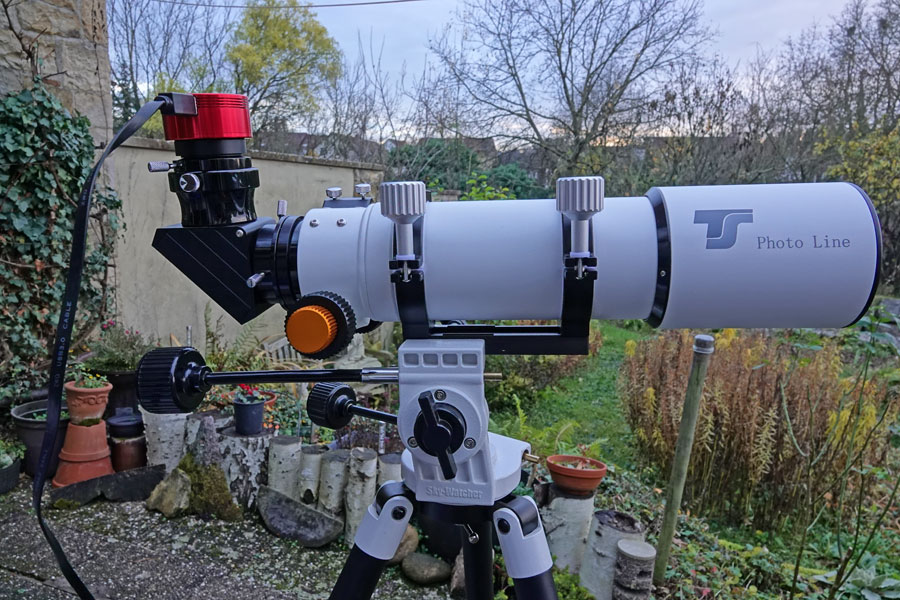 |
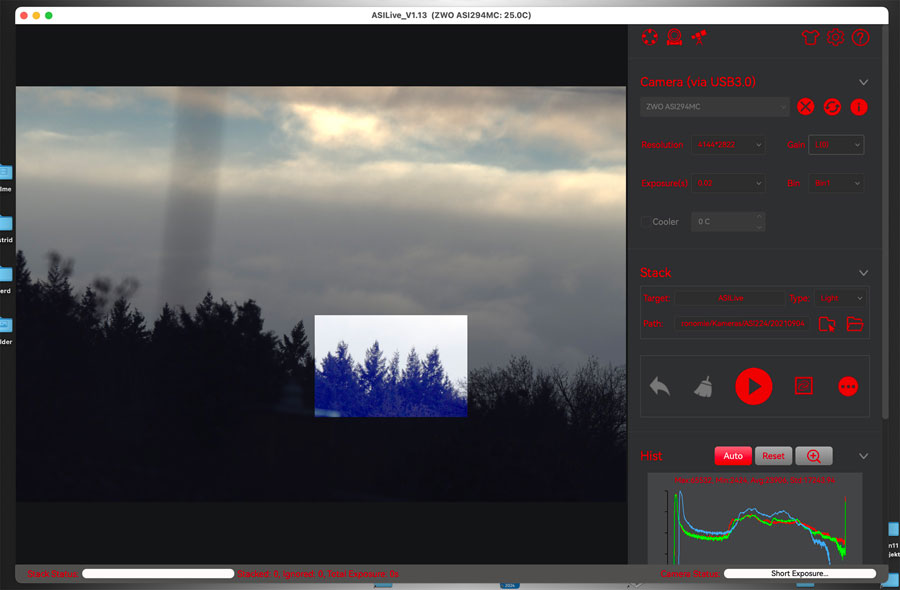 |
| With Omegon 2" zenith mirror | With Omegon 2" zenith mirror |
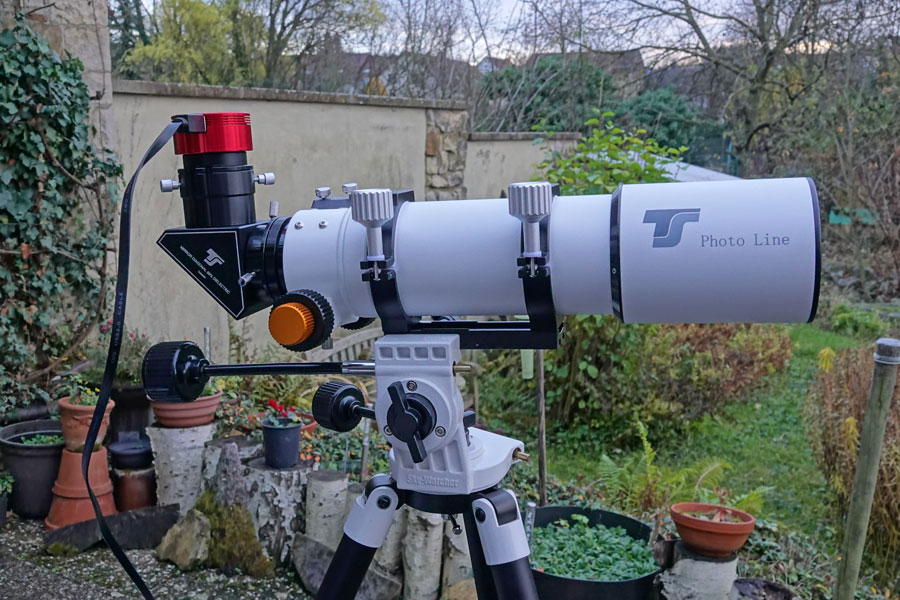 |
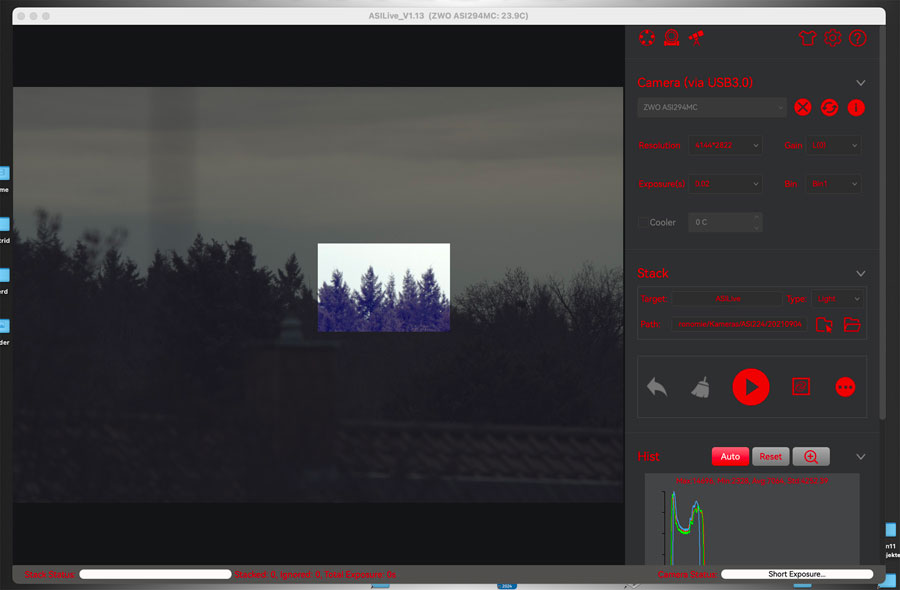 |
| With TS-Optics 2" zenith mirror | With TS-Optics 2" zenith mirror |
Issues and Solutions
Focuser
When I tried out the focuser of the unpacked telescope, I noticed that it had some play, especially when I changed the direction of focusing. Then it took 1-2 mm for the focuser to catch (and there was a noise...). If I then continued to focus in the same direction, I could no longer feel any play because the mechanics was now "at the stop".
I then looked at the back of the focuser and found 4 holes for grub screws; the holes were already a bit dirty. I found a suitable Allen key in my supplies and used it to check the grub screws. It turned out that three of the screws were not tight, and the wrench did not seem to fit the fourth. First I tightened the right-hand grub screw (not too tight, center photo), and then the focuser showed no more play - everything was now OK. Then I tightened two more grub screws a little more and finally realized that the fourth grub screw was missing. As you can see in the photo (larger version), you can see through the hole for the grub screw, so there does not seem to be anything to tighten. Maybe that is why the fourth screw is missing... I will try to ask TS-Optics about this.
There are 6 further screw holes on the underside of the focuser, 5 of which have grub screws (right-hand photo). One hole has a thumb screw. If you tighten it, you lock the focuser in place, which can be particularly useful when taking photos. I do not know what function the other grub screws have. I preferred not to touch them!
By the way, you can also buy the focuser alone: TS-Optics 2.5" RAP focuser with M86x1 telescope mount.
Mount/Tripod
AZ Pronto Mount
I would like to use the TLAPO804 on my AZ Pronto mount and have already made some initial attempts with it. The mount is designed for loads of up to 3 kg, and the TLAPO804 with tube clamps already weighs over 3 kg. This mount is actually too heavy for that mount! I can see this, especially at night, from the fact that the image shakes a lot when touched and only settles down very slowly. The mount head is also specified with a load capacity of 3 kg in advertisements, but it seems to me to be more resilient. The vertical axis is certainly the weak point here; it becomes somewhat "jerky" under load. Well, I have the impression that it works...
Photos with the TLAPO804 on the AZ Pronto mount can be found above!
Gitzo Carbon Tripod
However, it makes sense to me to replace the aluminum tripod of the AZ Pronto mount with a more stable tripod. I just sold my AZ5 tripod, but it was also large and heavy. However, for the Vespera I bought a Gitzo carbon tripod that can hold up to 25 kg, which would be ideal! I have already tried it out once and everything fits well.
 |
 |
TLAPO804 on Gitzo carbon tripod |
TLAPO804 on Gitzo carbon tripod (with AZ Pronto mount head) |
You can remove a support plate from the tripod, screw it to the AZ Pronto mount head and put both back into the tripod. Here are photos of the support plate:
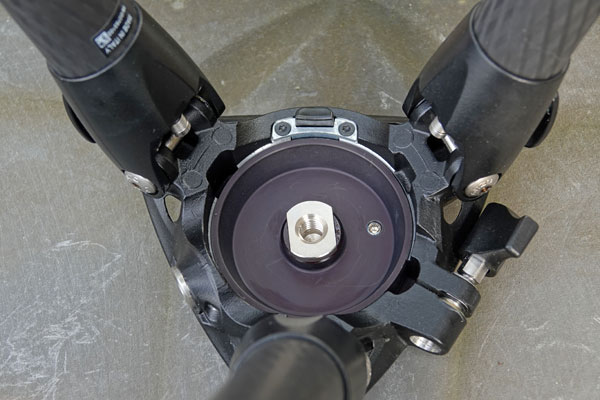 |
 |
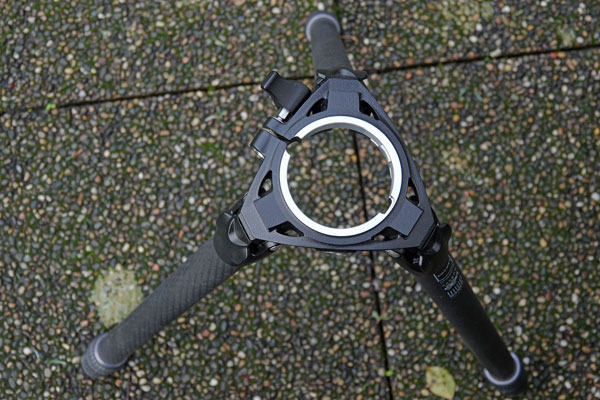 |
Tripod from underneath with support plate |
Tripod from above with support plate |
Tripod from above, support plate removed |
However, the whole thing has its problems! I did not screw the head onto the support plate tightly enough, and when I turned the telescope by hand, the connection came loose again and the telescope started to wobble. I then screwed both tighter, but then I had the problem that I was not able to separate the mount head and the support plate when dismantling. Perhaps this would work better if I used a wrench on the underside of the support plate (see photo; this would also work for tightening...).
I should also loosen the horizontal axis of the mount head if I want to turn the telescope manually (this is quicker than using the fine adjustment of the head). And then, of course, tighten it again a little so that the fine adjustment works...
AZ5 Mount Head
Because I did not really trust the AZ Pronto mount head, especially with regard to the vertical axis, I bought a more stable AZ5 mount head at the end of 2024 (although, see above, I had sold the AZ5 tripod because it was too heavy for me) in order to operate the TLAPO804 with this head, which is designed for slightly higher loads, on the Gitzo carbon tripod.
 |
 |
However, since the mounting in this head is vertical, I have to rotate the refractor in its tube clamps by 90°, which is a bit annoying (at least, if you want to switch between the two mount heads)...
More photos with the TLAPO804 on the AZ5 mount head with the Gitzo carbon tripod can be found above!
First Conclusions
in progress
So far I have only used my TLAPO804 refractor a little, so it is too early even for a first conclusion. But after the few observations I have made with it, I am very happy with it because it is handy and quick to use. At least visually, and since I have sold all my astrophotography equipment, I will only use it visually.
Unfortunately, the stars are not as round as I would have liked, but that is probably less a problem with the refractor than with my eyes...
Links
- TS-Optics PHOTOLINE 80 mm f/6 FPL53 Triplet Apo - 2.5" RAP Focuser (TS-Optics): www.teleskop-express.de/en/ts-teleskope-143/all-apos-and-eds-from-all-manufacturers-large-overview-223/like-new-ts-optics-photoline-80-mm-f-6-fpl53-triplet-apo-2-5-rap-focuser-18034 - www.teleskop-express.de/en/telescopes-4/apochromatic-refractor-55/all-apos-und-eds-223/ts-optics-photoline-80-mm-f-6-fpl53-triplet-apo-2-5-rap-focuser-3881
- 6x30 finder scope with angled eyepiece and upright non-reversed image: www.astroshop.eu/optical-finders/skywatcher-6x30-finder-scope-with-angled-eyepiece-and-upright-non-reversed-image/p,16115
- See also my page offering Astronomy Links.
Appendix: Data for TS-Optics TLAPO804 Refractor
Technical Data
| Telescope: Omegon | TLAP804 |
| Optical Design | Refractor (Triplet) |
| Primary Mirror Diameter | 80 mm |
| Focal Length, Focal Ratio | 480 mm, f/6 |
| Resolving Power (arc secs) | 1.45" |
| Limiting Visual Stellar Magnitude | about 11.5 mag |
| Light Gathering Power | 130.6 |
| Maximum Practical Visual Power | 160 x |
| Optical Tube Dimensions (diam. x length) | 8.9/10.3 cm x 37.5 cm (transport size) |
| Net Weight Basis | n.a. |
| Net Weight Optical Tube | 3.14 kg with pipe clamps |
| Net Weight Complete | n.a. |
Dark Blue: Telescopes that I still own; italic and dark red: telescopes that I owned; black: for comparison; *) own measurement
See also the table of data for all of my telescopes (and a few more...)
Observation-Relevant Data (in Comparison with PS72, ST120, TLAPO1027, and PDS150 Newton Tube)
| Telescope | Focal |
Aperture (mm) |
Focal Ratio |
Light Gathering Power |
Maximum+ |
Minimum* |
Maximum* |
Minimum+ |
|||||
Usable Magnification |
Usable Focal
Length of Eyepiece (mm) |
||||||||||||
Factor/Exit Pupil (mm) > |
Manuf. |
1.5 |
2 |
6.5 |
7 |
6.5 |
7 |
1.5 |
2 |
||||
| PS 72/432 | 432 |
72 |
6 |
106 |
144 |
108 |
144 |
11.08 |
10.29 |
39.0 |
42.0 |
4.0 |
3.0 |
| ST120 | 600 |
120 |
5 |
290 |
180 |
240 |
18.46 |
17.14 |
32.5 |
35.0 |
3.3 |
2.5 |
|
| TLAPO804 | 480 |
80 |
6 |
130.6 |
120 | 160 | 12.31 | 11.43 | 39.0 |
42.0 |
4.0 |
3.0 |
|
| TLAPO1027 | 714 |
102 |
7 |
212.3 |
153 |
204 |
15.69 |
14.57 |
45.5 |
49.0 |
4.7 |
3.5 |
|
| Explorer PDS150/Dobson 6" | 750 |
150
|
5 |
459 |
225 |
300 |
23.08 |
21.43 |
32.5 |
35.0 |
3.3 |
2.5 |
|
*) Calculated for an exit pupil of 6.5 mm and 7 mm
+) Factor 1.5 or 2 for Dobsonian/Newtonian telescopes; in general, the lower
value of 1.5 is used for Newtonian telescopes; if the manufacturer specified
a different magnification, it is also listed (some manufacturer provide considerably
higher numbers...).
Visual Power (Magnification) and Other Data for Different Focal Lengths of Eyepieces (Mostly My Current Eyepieces)
Note: These tables include the StarTravel 120 refractor, a TSWA32 eyepiece (2", 32 mm focal length, 70° viewing angle) that I borrowed together with the StarTravel 120, a 18 mm eyepiece (2", 82° viewing angle), a 38 mm eyepiece (2", 70° viewing angle), and a 56 mm eyepiece (2", 52° viewing angle).
| Magnification | Focal Length of Eyepiece (mm) |
|||||||||||||||
| Telescope | Focal Length of Telescope (mm) |
4 |
7 |
10 |
16 |
18 |
24 |
26 |
32 |
32 |
35 |
38 |
40 |
56 |
||
| PS 72/432 | 432 |
108.00 |
61.71 |
43.20 |
27.00 |
24.00 |
18.00 |
16.62 |
13.50 |
13.50 |
12.34 |
11.37 |
10.80 |
7.71 |
||
| ST120 | 600 |
150.00 |
85.71 |
60.00 |
37.50 |
33.33 |
25.00 |
23.08 |
18.75 |
18.75 |
17.14 |
15.79 |
15.00 |
10.71 |
||
| TLAPO804 | 480 |
120.00 |
68.57 |
48.00 |
30.00 |
26.67 |
20.00 |
18.46 |
15.00 |
15.00 |
13.71 |
12.63 |
12.00 |
8.57 |
||
| TLAPO1027 | 714 |
178.50 |
102.00 |
71.40 |
44.63 |
39.67 |
29.75 |
27.46 |
22.31 |
22.31 |
20.40 |
18.79 |
17.85 |
12.75 |
||
| 150PDS | 750 |
187.50 |
107.14 |
75.00 |
46.88 |
41.67 |
31.25 |
28.85 |
23.44 |
23.44 |
21.43 |
19.74 |
18.75 |
13.39 |
||
| SM127 | 1500 |
375.00 |
214.29 |
150.00 |
93.75 |
--- |
62.50 |
--- |
46.88 |
--- |
--- |
--- |
--- |
--- |
||
| SM102 | 1300 |
325.00 |
185.71 |
130.00 |
81.25 |
--- |
54.17 |
--- |
40.63 |
--- |
--- |
--- |
--- |
--- |
||
| C5 | 1250 |
312.50 |
178.57 |
125.00 |
78.13 |
--- |
52.08 |
--- |
39.06 |
39.06 |
35.71 |
32.89 |
31.25 |
22.32 |
||
| C5 (Red.) | 787.5 |
196.88 |
112.50 |
78.75 |
49.22 |
--- |
32.81 |
--- |
24.61 |
--- |
--- |
--- |
--- |
--- |
||
| C8 | 2032 |
508.00 |
290.29 |
203.20 |
127.00 |
112.89 |
84.67 |
78.15 |
63.50 |
63.50 |
58.06 |
53.47 |
50.80 |
36.29 |
||
| C8 (Red.) | 1280 |
320.00 |
182.86 |
128.00 |
80.00 |
--- |
53.33 |
--- |
40.00 |
--- |
--- |
--- |
--- |
--- |
||
| True Field of View (°) | Focal Length of Eyepiece (mm) |
Camera |
||||||||||||||
Apparent FOV (°) > |
82 |
82 |
72 |
82 |
82 |
65 |
70 |
52 |
70 |
69 |
70 |
68 |
52 |
ZWO |
Atik |
|
| Telescope | Focal Length of Telescope (mm) |
4 |
7 |
10 |
16 |
18 |
24 |
26 |
32 |
32 |
35 |
38 |
40 |
56 |
ASI294 |
Infinity |
| PS 72/432 | 432 |
0.76 |
1.33 |
1.67 |
3.04 |
3.42 |
3.61 |
4.21 |
3.85 |
5.19 |
5.59 |
6.16 |
6.30 |
6.74 |
2.54° x 1.73° | 1.19° x 0.89° |
| ST120 | 600 |
0.55 |
0.96 |
1.20 |
2.19 |
2.46 |
2.60 |
3.03 |
2.77 |
3.73 |
4.03 |
4.43 |
4.53 |
4.85 |
||
| TLAPO804 | 480 |
0.68 |
1.20 |
1.50 |
2.73 |
3.08 |
3.25 |
3.79 |
3.47 |
4.67 |
5.03 |
5.54 |
5.67 |
6.07 |
2.29° x 1.56° | |
| TLAPO1027 | 714 |
0.46 |
0.80 |
0.91 |
1.84 |
2.07 |
2.18 |
2.55 |
2.33 |
3.14 |
3.38 |
3.73 |
3.92 |
4.08 |
1.54° x 1.05° | 0.72° x 0.54° |
| 150PDS | 750 |
0.44 |
0.77 |
0.96 |
1.75 |
1.97 |
2.08 |
2.43 |
2.22 |
2.99 |
3.22 |
3.55 |
3.63 |
3.88 |
||
| SM127 | 1500 |
0.22 |
0.38 |
0.48 |
0.87 |
--- |
1.04 |
--- |
1.11 |
--- |
--- |
--- |
--- |
--- |
||
| SM102 | 1300 |
0.25 |
0.44 |
0.55 |
1.01 |
--- |
1.20 |
--- |
1.28 |
--- |
--- |
--- |
--- |
--- |
||
| C5 | 1250 |
0.26 |
0.46 |
0.58 |
1.05 |
--- |
1.25 |
--- |
1.33 |
1.79 |
1.93 |
2.13 |
2.18 |
2.33 |
0.88° x 0.60° | 0.41° x 0.31° |
| C5 (Red.) | 787.5 |
0.42 |
0.73 |
0.91 |
1.67 |
--- |
1.98 |
--- |
2.11 |
--- |
--- |
--- |
--- |
--- |
1.40° x 0.95° | 0.65° x 0.49° |
| C8 | 2032 |
0.16 |
0.28 |
0.35 |
0.65 |
0.73 |
0.77 |
0.90 |
0.82 |
1.10 |
1.19 |
1.31 |
1.34 |
1.43 |
0.54° x 0.37° | 0.25° x 0.19° |
| C8 (Red.) | 1280 |
0.26 |
0.45 |
0.63 |
1.03 |
--- |
1.22 |
--- |
1.30 |
--- |
--- |
--- |
--- |
--- |
0.86° x 0.58° | 0.4° x 0.3° |
| Exit Pupil (mm) | Focal Length of Eyepiece (mm) |
|||||||||||||||
| Telescope | Focal Ratio |
4 |
7 |
10 |
16 |
18 |
24 |
26 |
32 |
32 |
35 |
38 |
40 |
56 |
||
| PS 72/432 | 6 |
0.67 |
1.17 |
1.67 |
2.67 |
3.00 |
4.00 |
4.33 |
5.33 |
5.33 |
5.83 |
6.33 |
6.67 |
9.33 |
||
| ST120 | 5 |
0.80 |
1.40 |
2.00 |
3.20 |
3.60 |
4.80 |
5.20 |
6.40 |
6.40 |
7.00 |
7.60 |
8.00 |
11.20 |
||
| TLAPO804 | 6 |
0.67 |
1.17 |
1.67 |
2.67 |
3.00 |
4.00 |
4.33 |
5.33 |
5.33 |
5.83 |
6.33 |
6.67 |
9.33 |
||
| TLAPO1027 | 7 |
0.57 |
1.00 |
1.43 |
2.29 |
2.57 |
3.43 |
3.71 |
4.57 |
4.57 |
5.00 |
5.43 |
5.71 |
8.00 |
||
| 150PDS | 5 |
0.80 |
1.40 |
2.00 |
3.20 |
3.60 |
4.80 |
5.20 |
6.40 |
6.40 |
7.00 |
7.60 |
8.00 |
11.20 |
||
| SM127 | 11.81 |
0.34 |
0.59 |
0.85 |
1.35 |
--- |
2.03 |
--- |
2.71 |
--- |
--- |
--- |
--- |
--- |
||
| SM102 | 12.75 |
0.31 |
0.55 |
0.78 |
1.26 |
--- |
1.88 |
--- |
2.51 |
--- |
--- |
--- |
--- |
--- |
||
| C5 | 10 |
0.40 |
0.70 |
1.00 |
1.60 |
--- |
2.40 |
--- |
3.20 |
3.20 |
3.50 |
3.80 |
4.00 |
5.60 |
||
| C5 (Red.) | 6.3 |
0.63 |
1.11 |
1.59 |
2.54 |
--- |
3.81 |
--- |
5.08 |
--- |
--- |
--- |
--- |
--- |
||
| C8 | 10 |
0.40 |
0.70 |
1.00 |
1.60 |
1.80 |
2.40 |
2.60 |
3.20 |
3.20 |
3.50 |
3.80 |
4.00 |
5.60 |
||
| C8 (Red.) | 6.3 |
0.63 |
1.11 |
1.59 |
2.54 |
--- |
3.81 |
--- |
5.08 |
--- |
--- |
--- |
--- |
--- |
||
Blue: Equipment borrowed for comparison purposes; gray: sold equipment; italic: 2" eyepieces
Magnification: Yellow: low (30-50 x); magenta: medium
(80-100 x); violet: high (150-200 x - and more); red: beyond
maximum usable magnification.
Exit pupil: Values in magenta cells are
either too small (< 1 mm) or too large (> 6.4/7 mm); yellow background:
best for galaxies (about 2-3 mm).
Recommendations for the Focal Lengths of Eyepieces for TLAPO804 (Following My Recommendations and Those of Others)
| Criteria | Exit Pupil |
Focal Length of Eyepiece |
|||||
| Category | Application Area | from...to |
Calculated |
On the Market |
Examples |
Existing |
|
| Maximum FOV | Search | 7 |
10 |
42-60 |
40-56* |
40...56* |
40 |
| Minimum Magnification / Large FOV | Overview, large-area nebulae | 4.5 |
6.5 |
27-39 |
28-38* |
28...38* |
26, 35 |
| Normal Magnification | Large-area, faint nebulae; nebulae, open star clusters | 3.5 |
4 |
21-24 |
20-25* |
20...25 |
24, 26 |
| Best for many objects, e.g. for most galaxies, and mid-size DSO | 2 |
3 |
12-18 |
12-18* |
12, 15, 16, 18 |
16 |
|
| Maximum Magnification / Maximum Resolution | "Normal" upper magnification limit; globular star clusters | 1 |
1.5 |
6-9 |
6-9 |
6, 7, 9 |
7, 10 |
| Maximum perceptibility of small, low-contrast details; planetary nebulae, small galaxies; maximum magnification for moon and planets |
0.6 |
0.8 |
3.5-5 |
3.5-5 |
4 |
4 |
|
| Separation of narrow double stars, small planetary nebulae; perception of faintest details |
0.4 |
0.5 |
2.4-3 |
2.5-3 |
3 |
--- |
|
*) Partly available as 2" eyepiece; **) typically no suitable 1,25" eyepieces available; problems with viewing at 40 mm; italic: not possible; red: magnification too high; blue: commercial focal lengths
Field of View
| 19.01.2025 |
